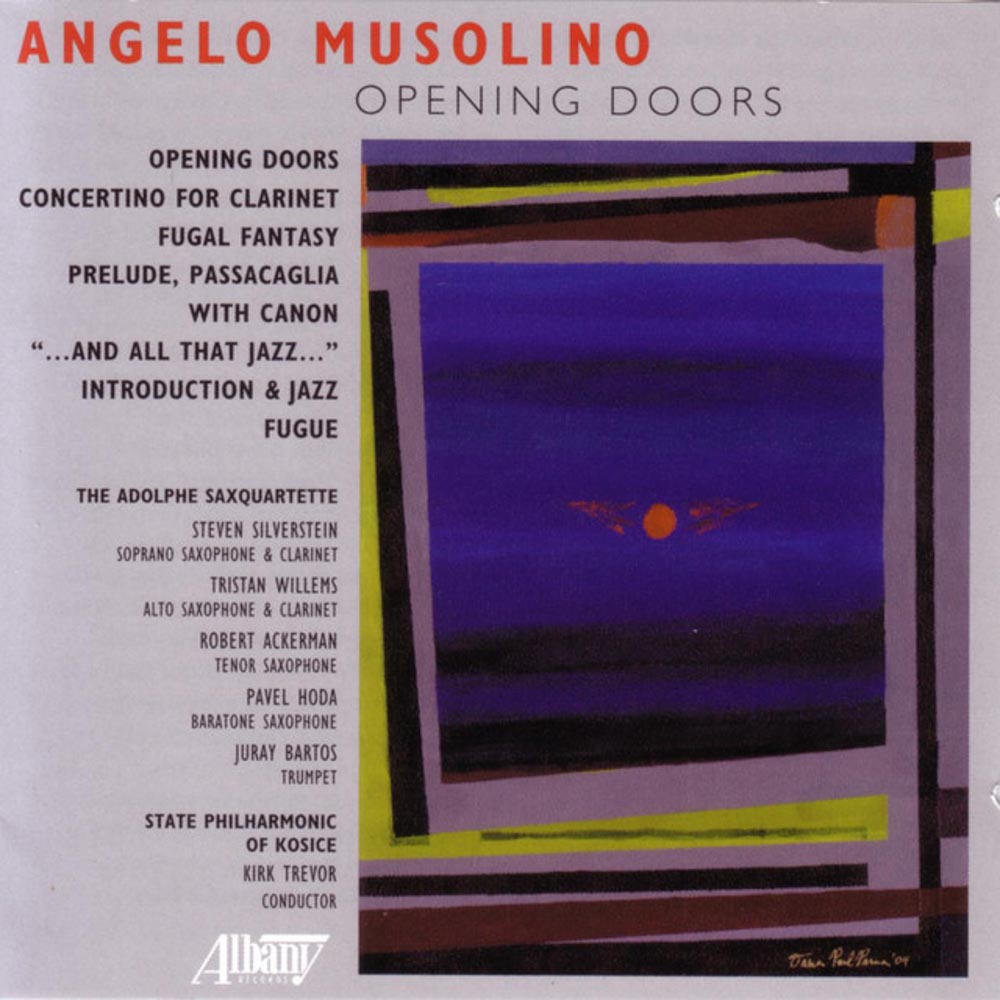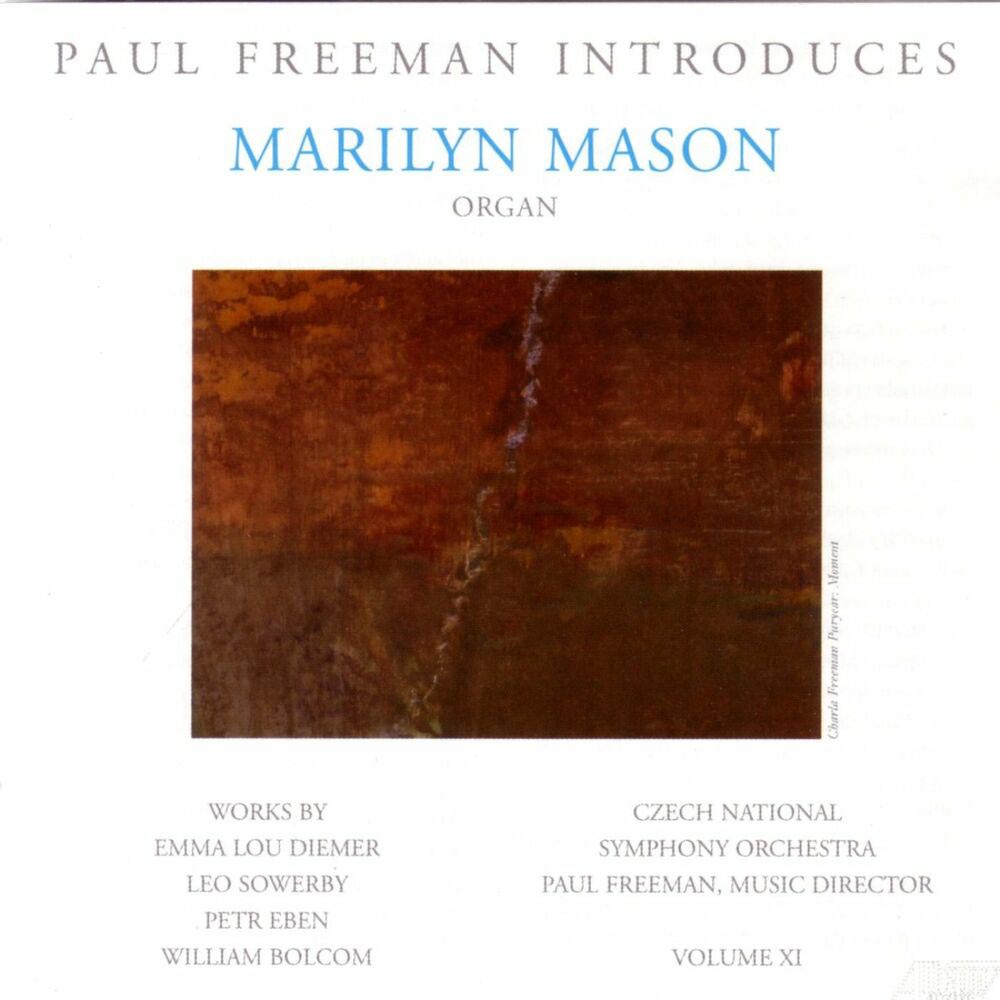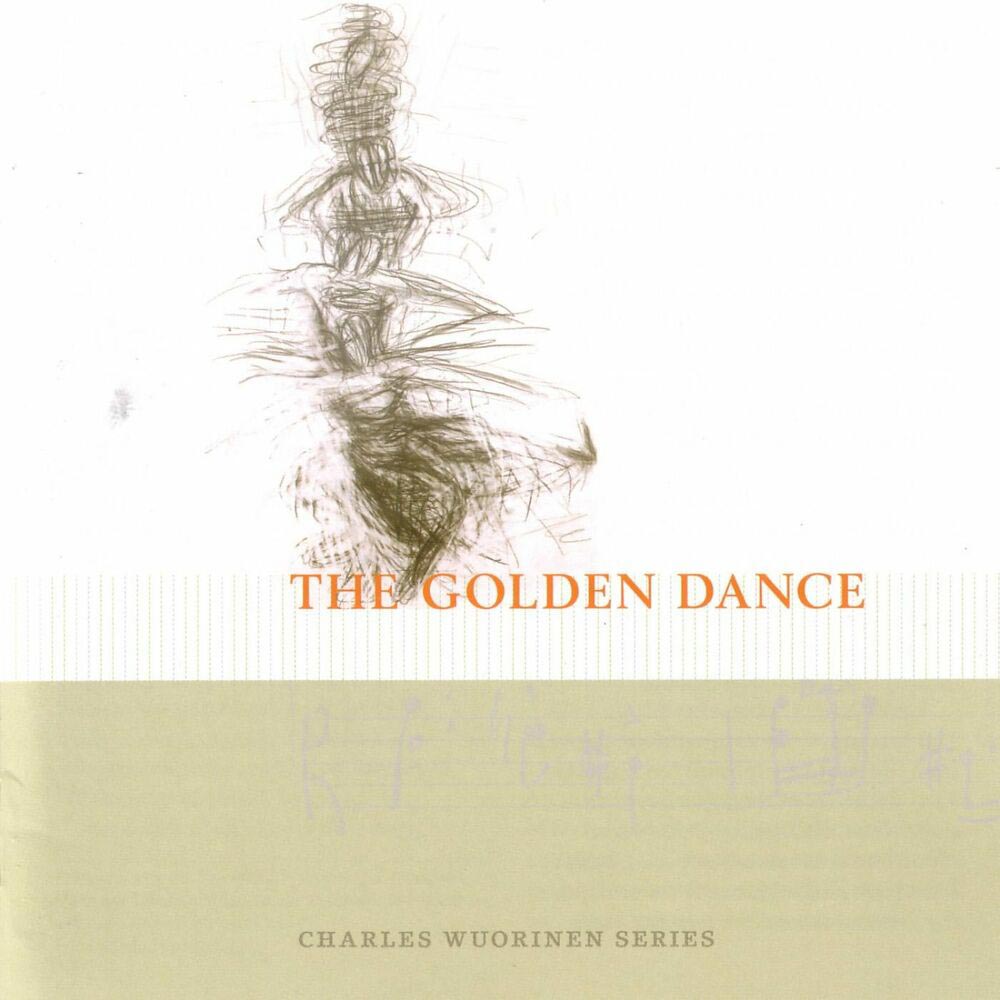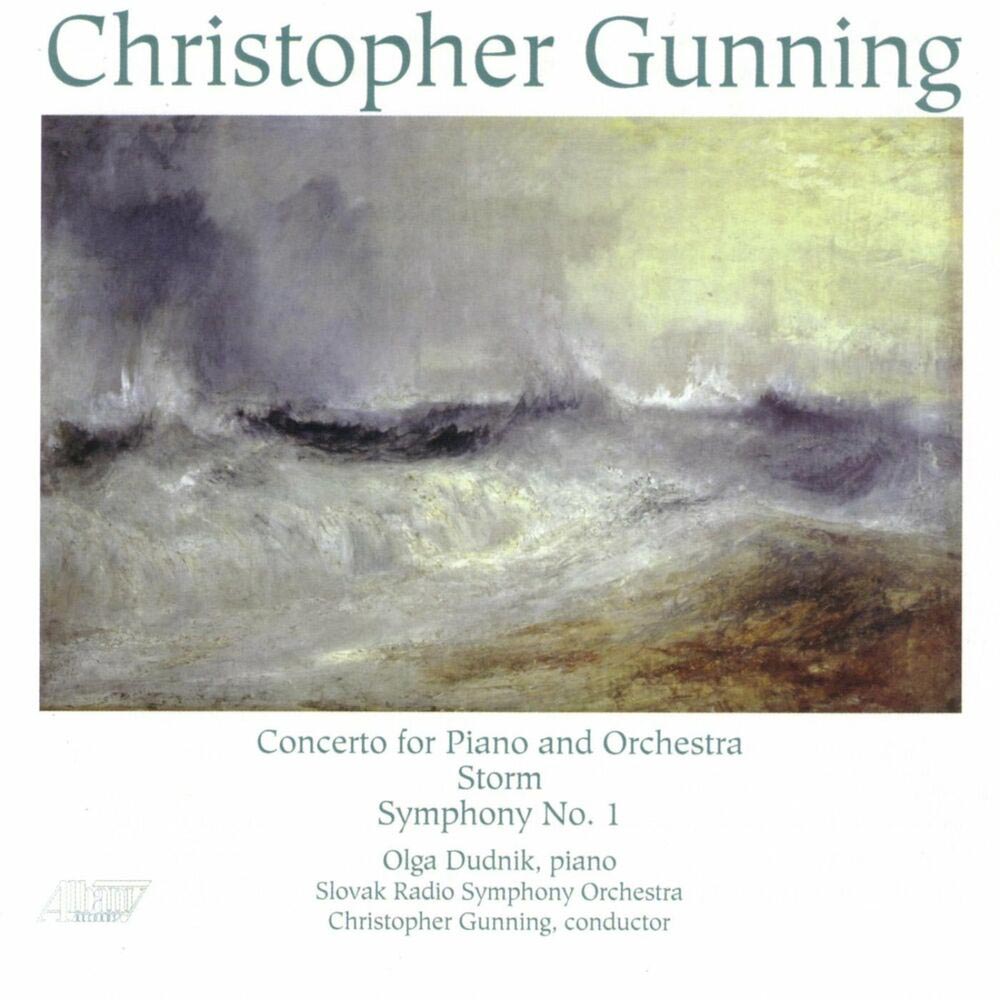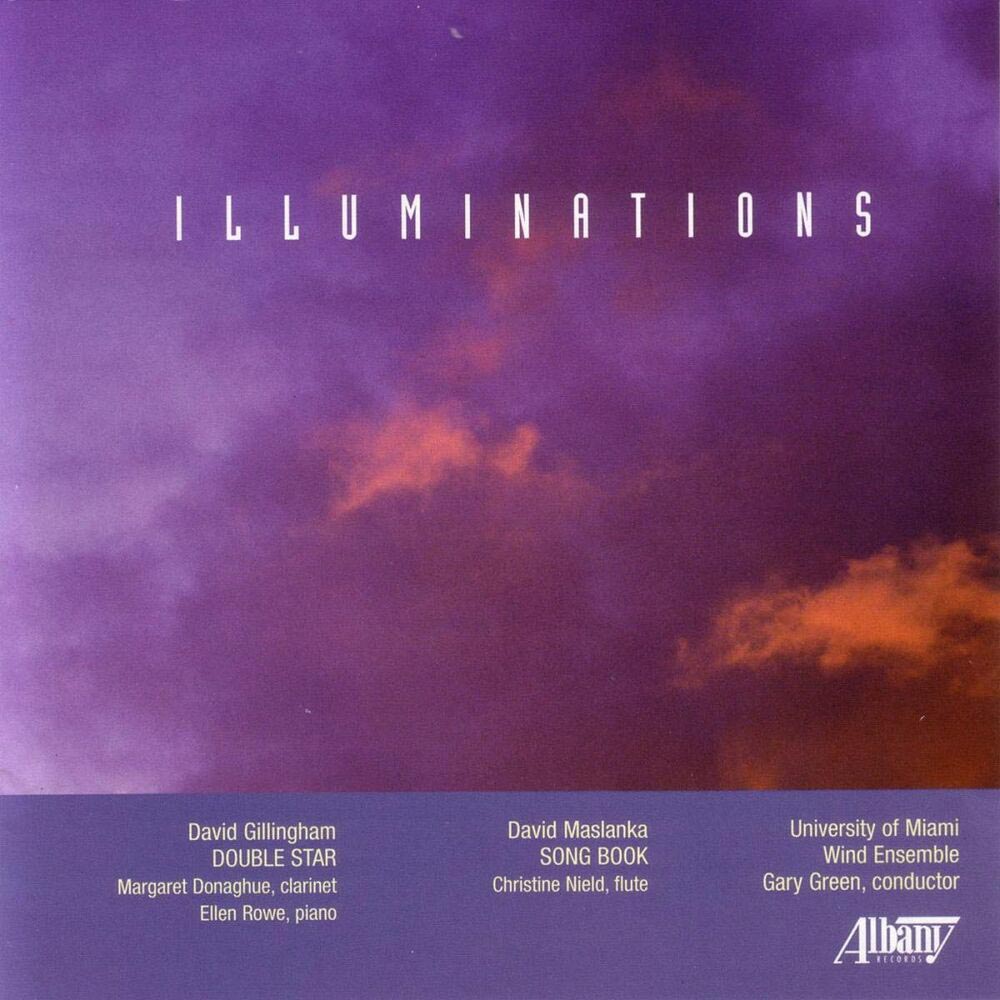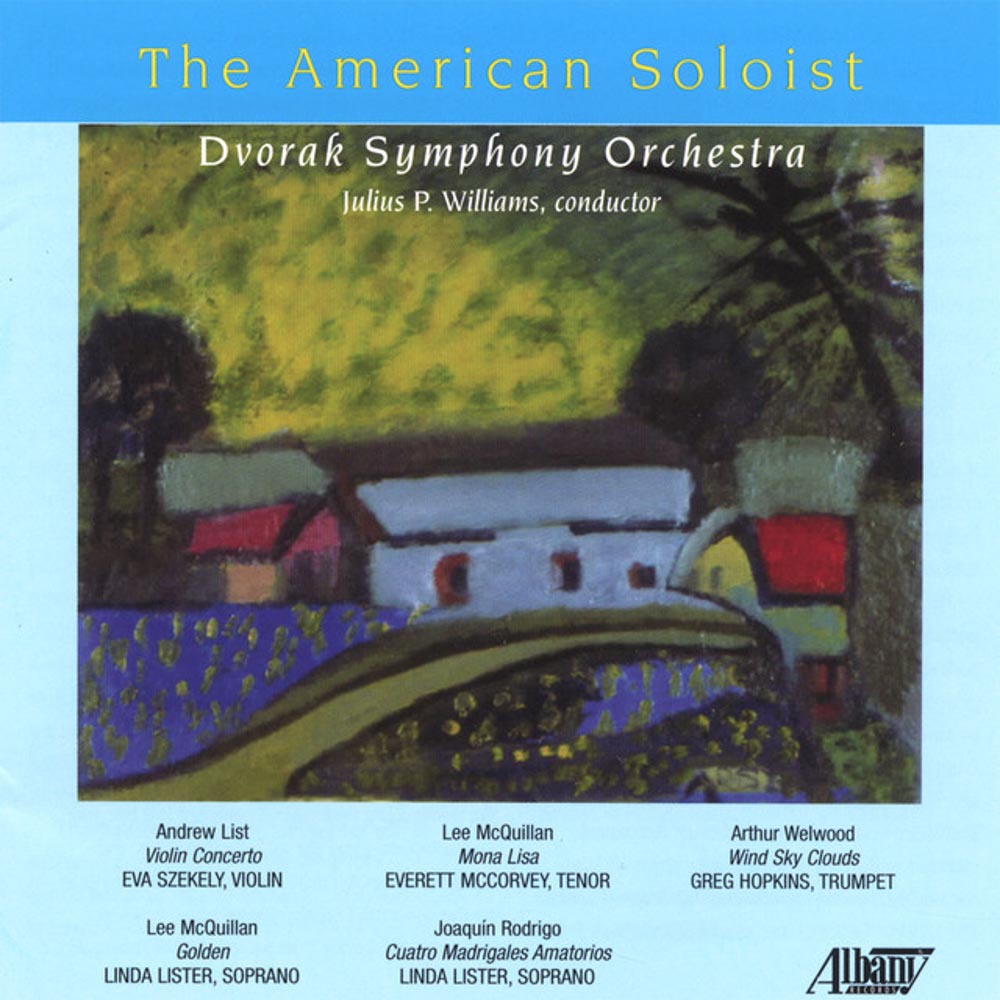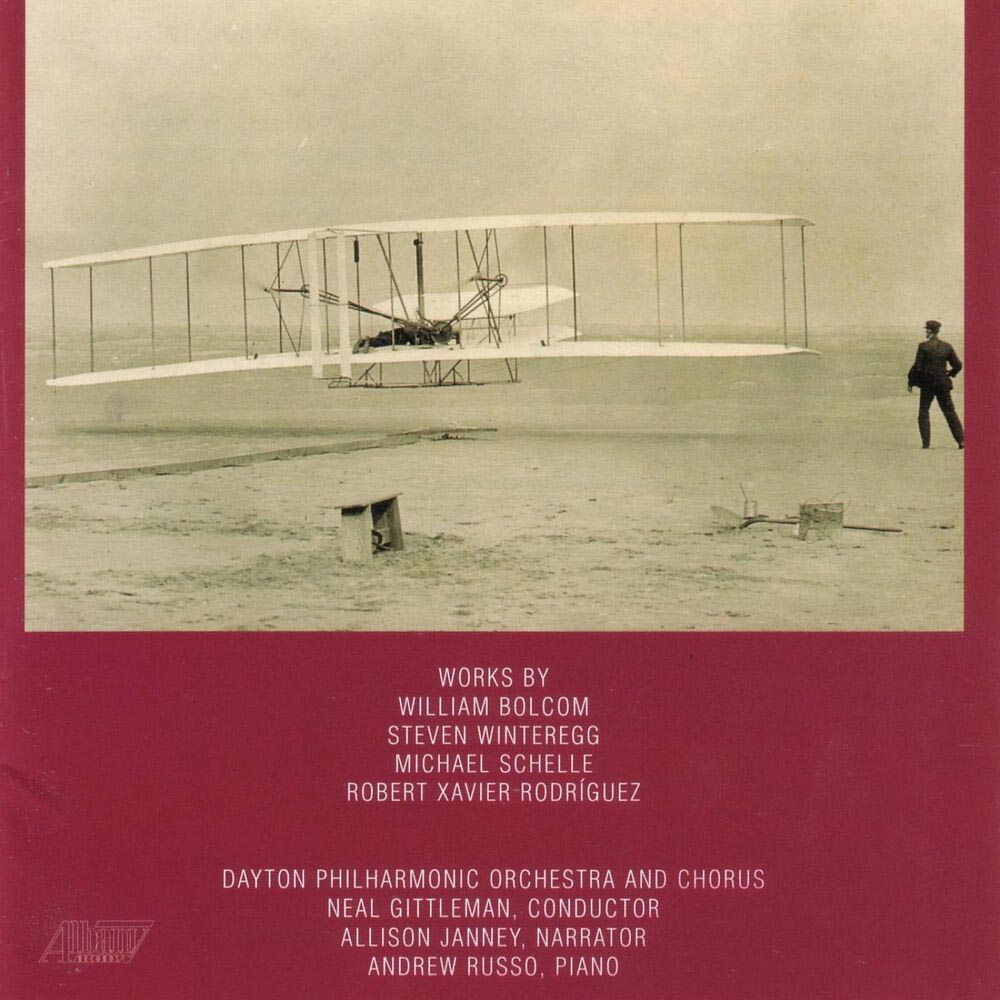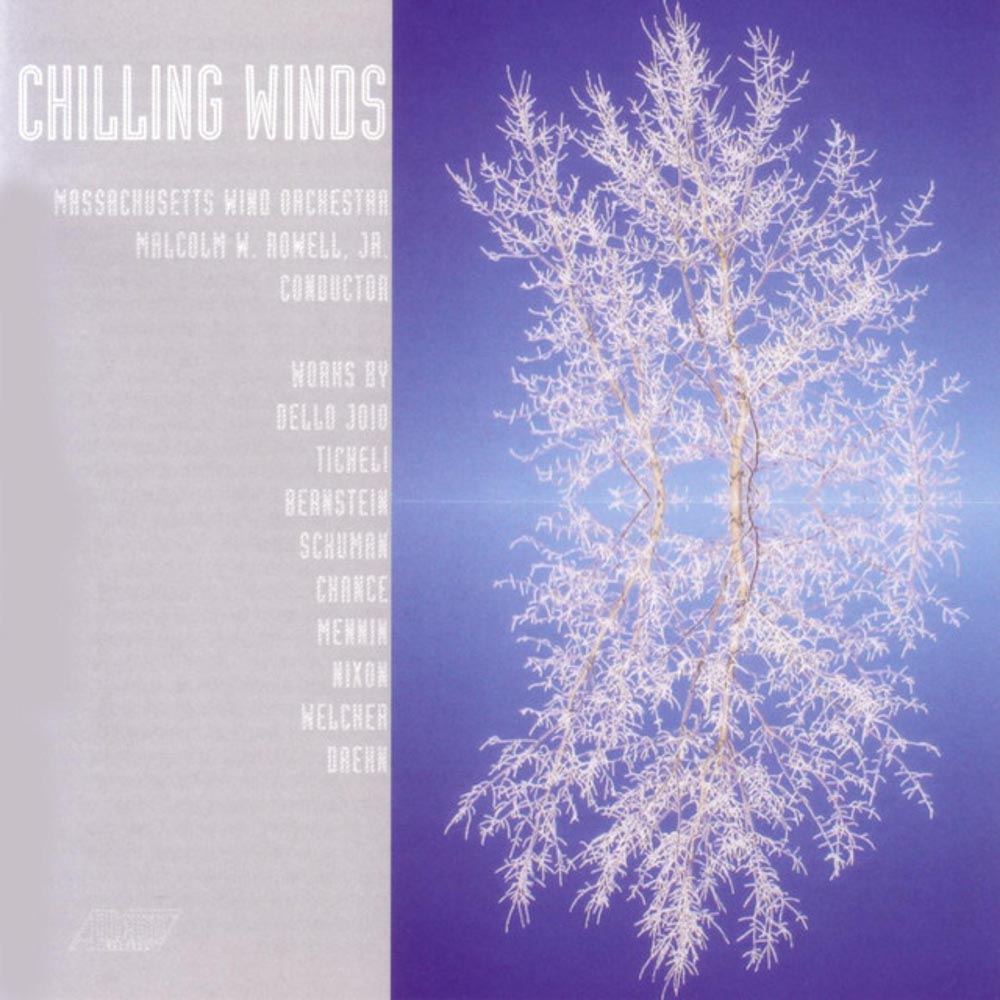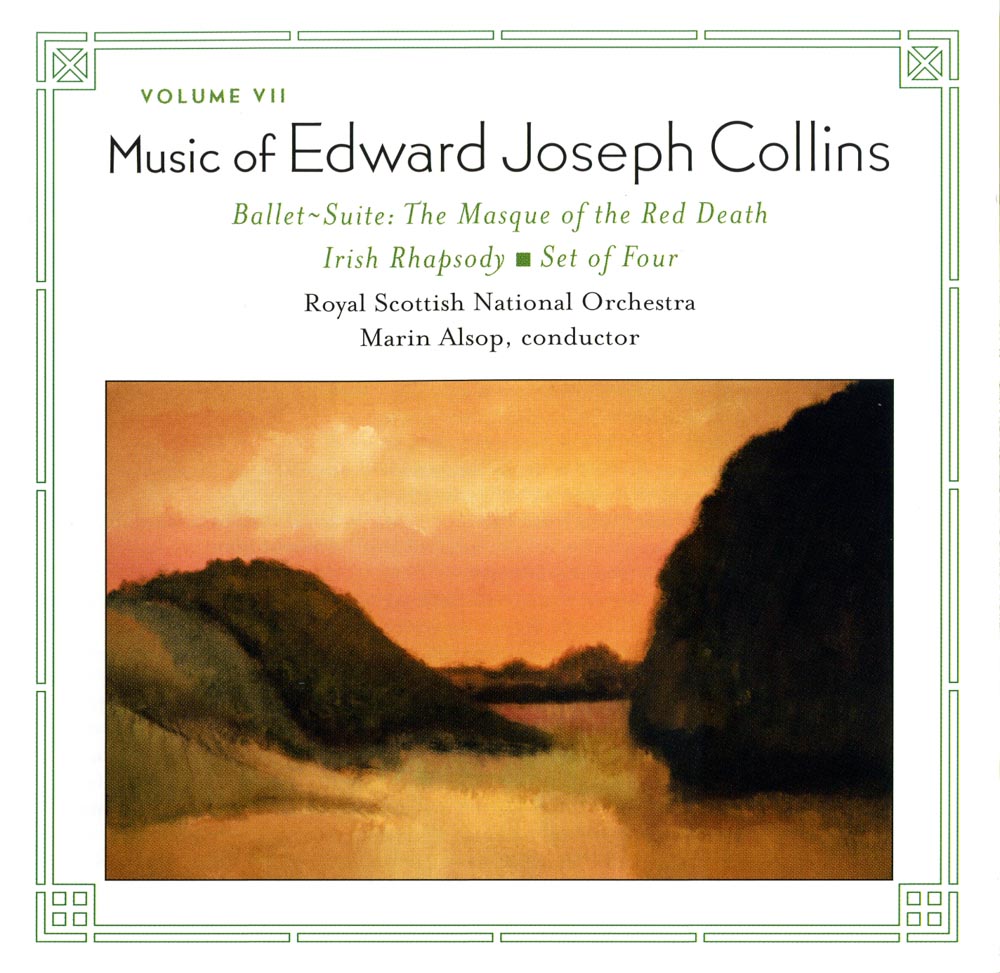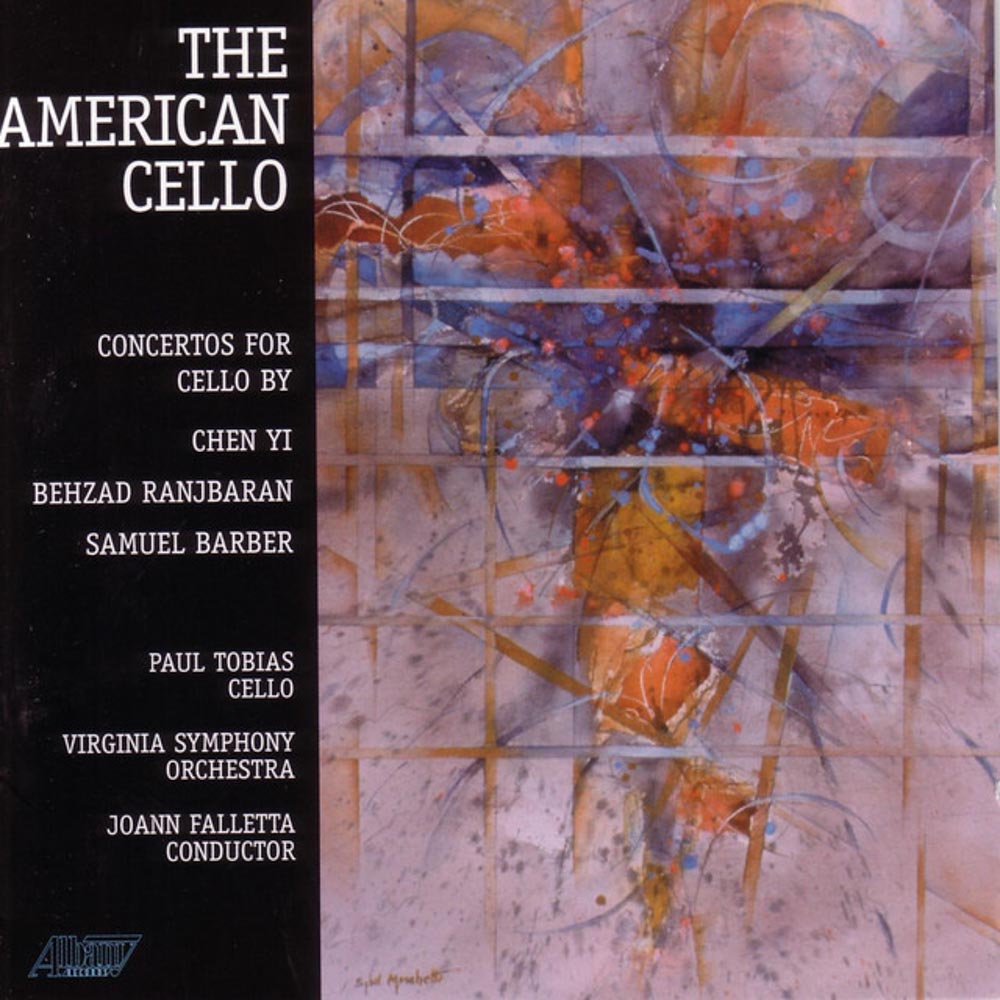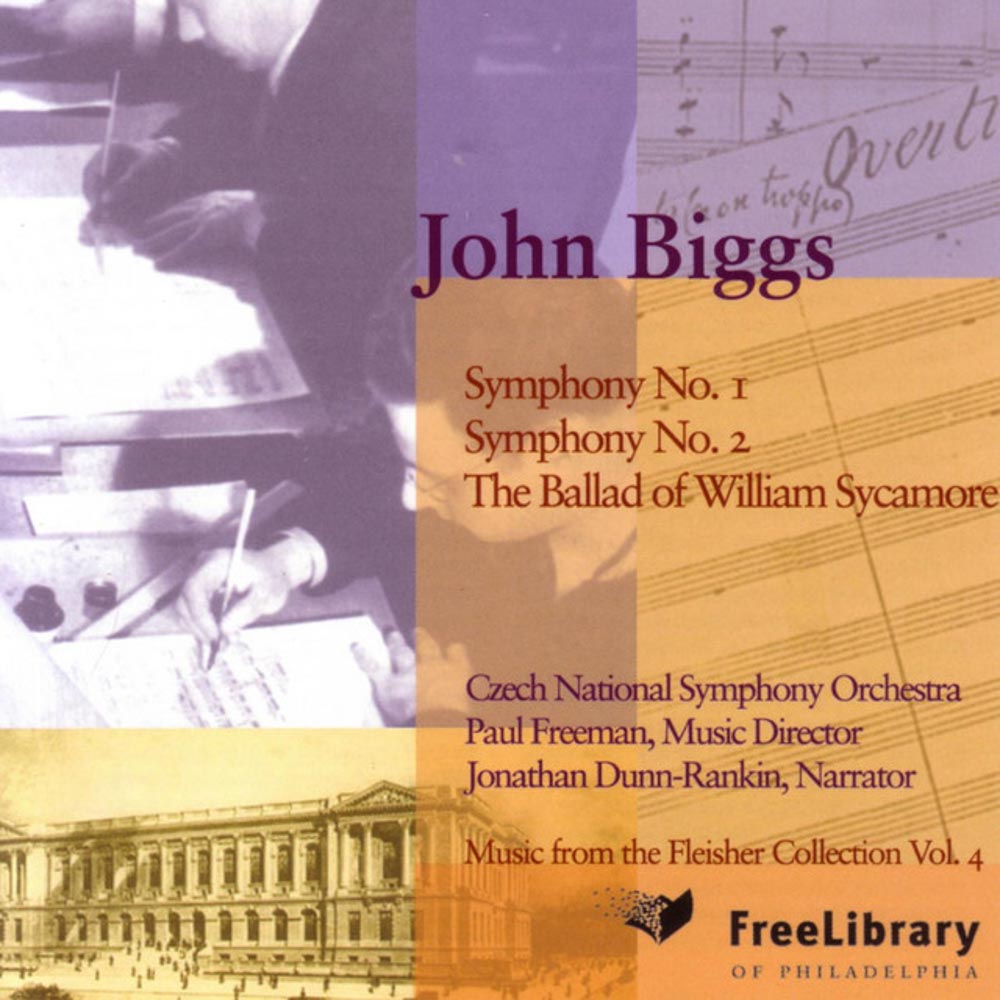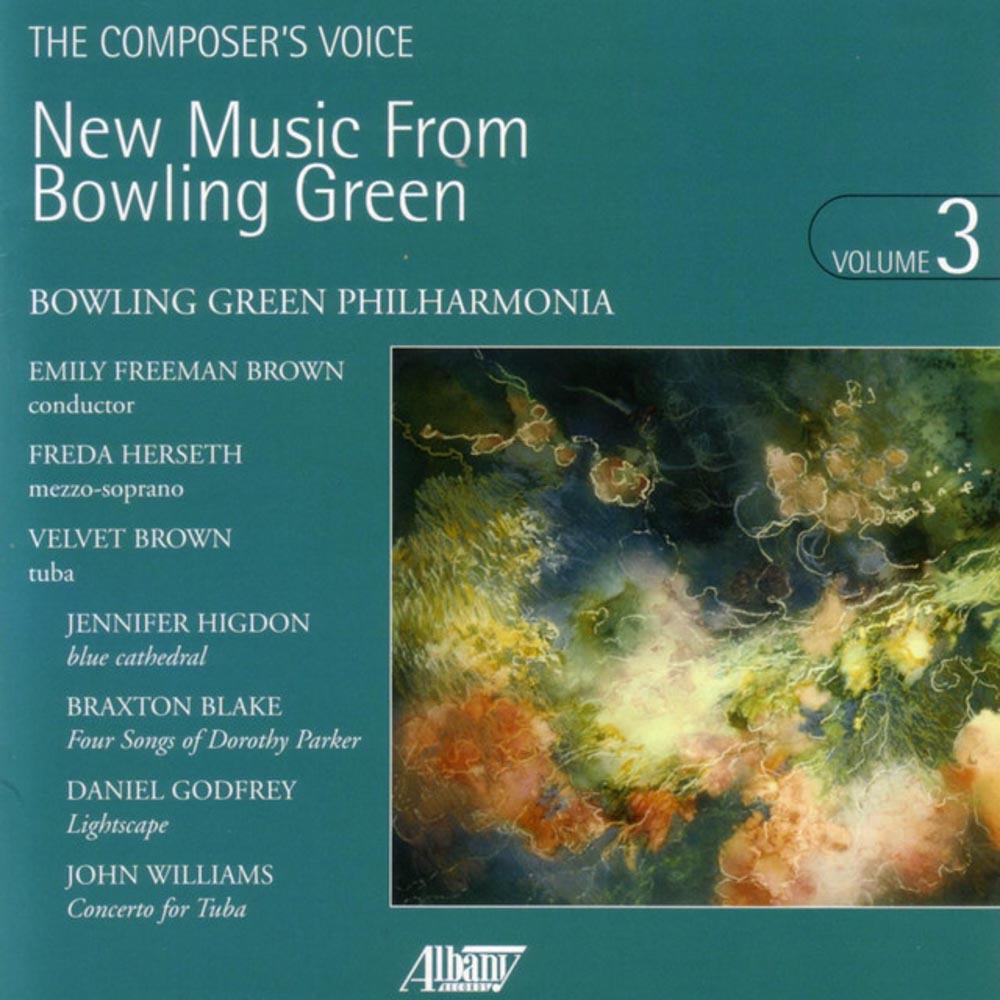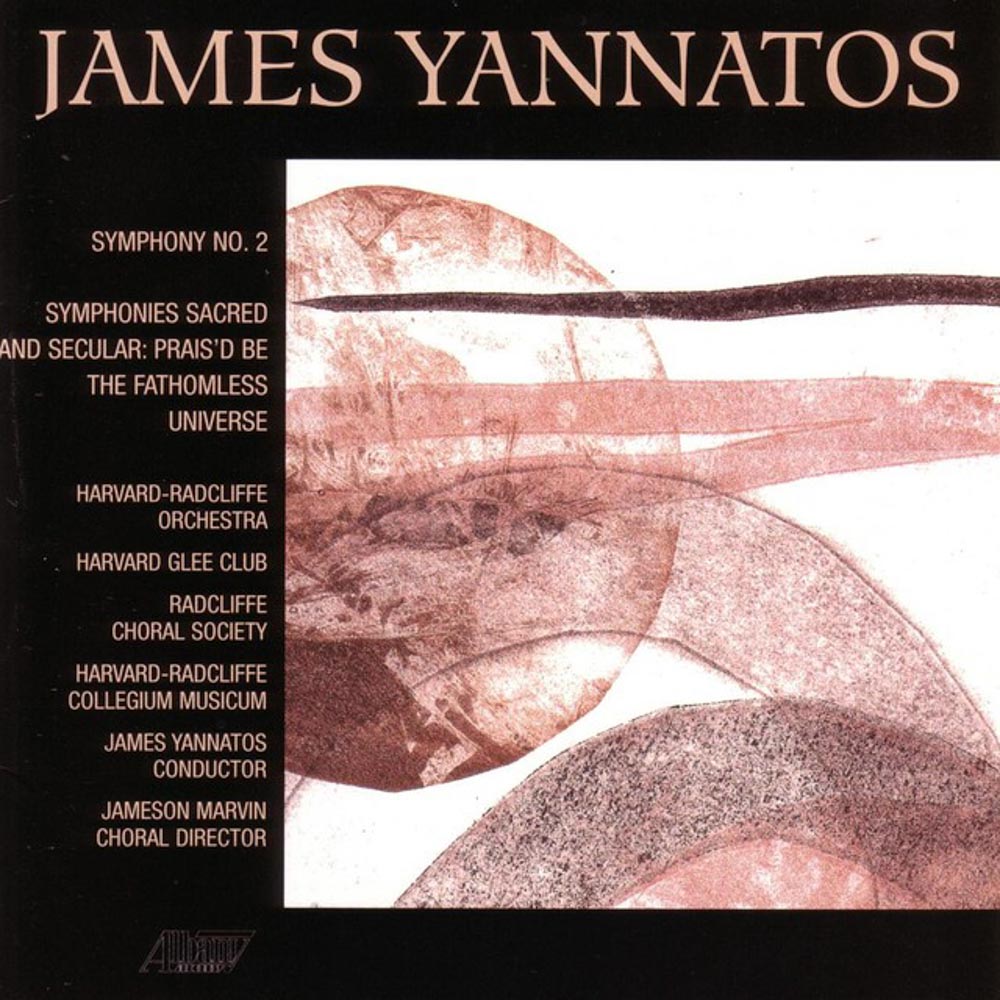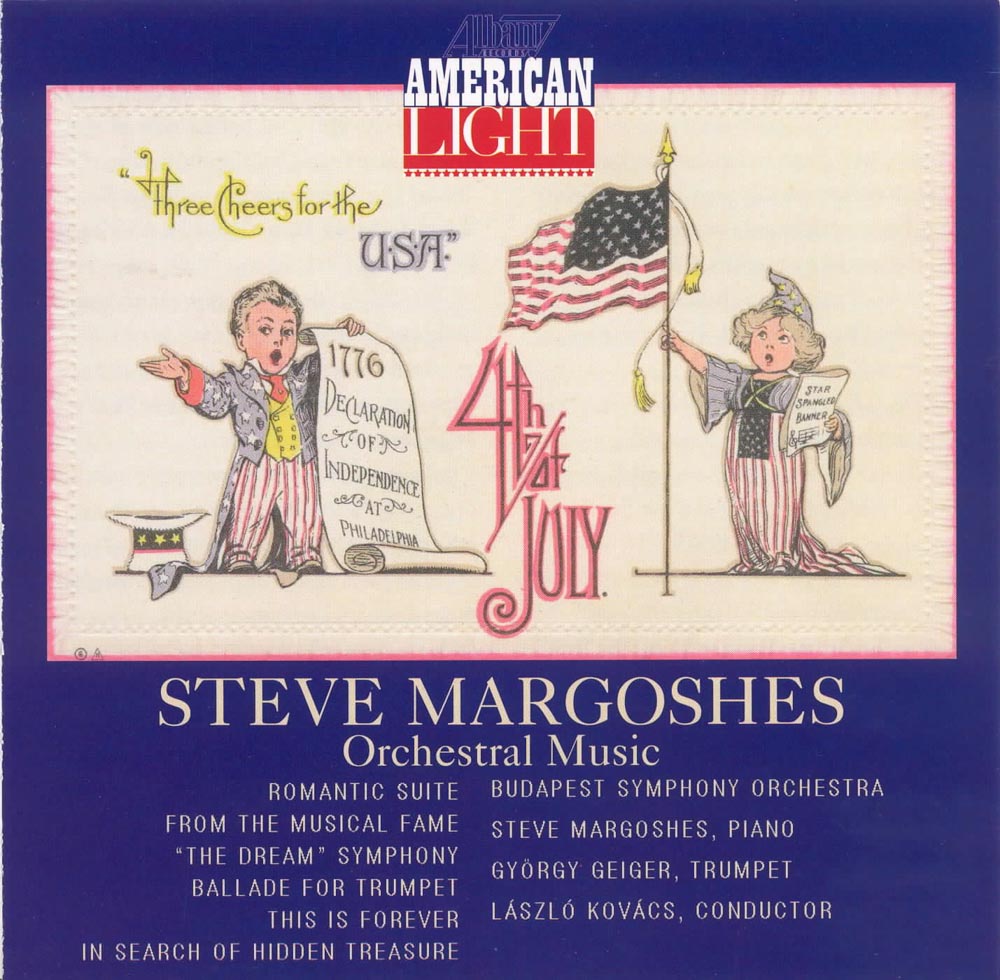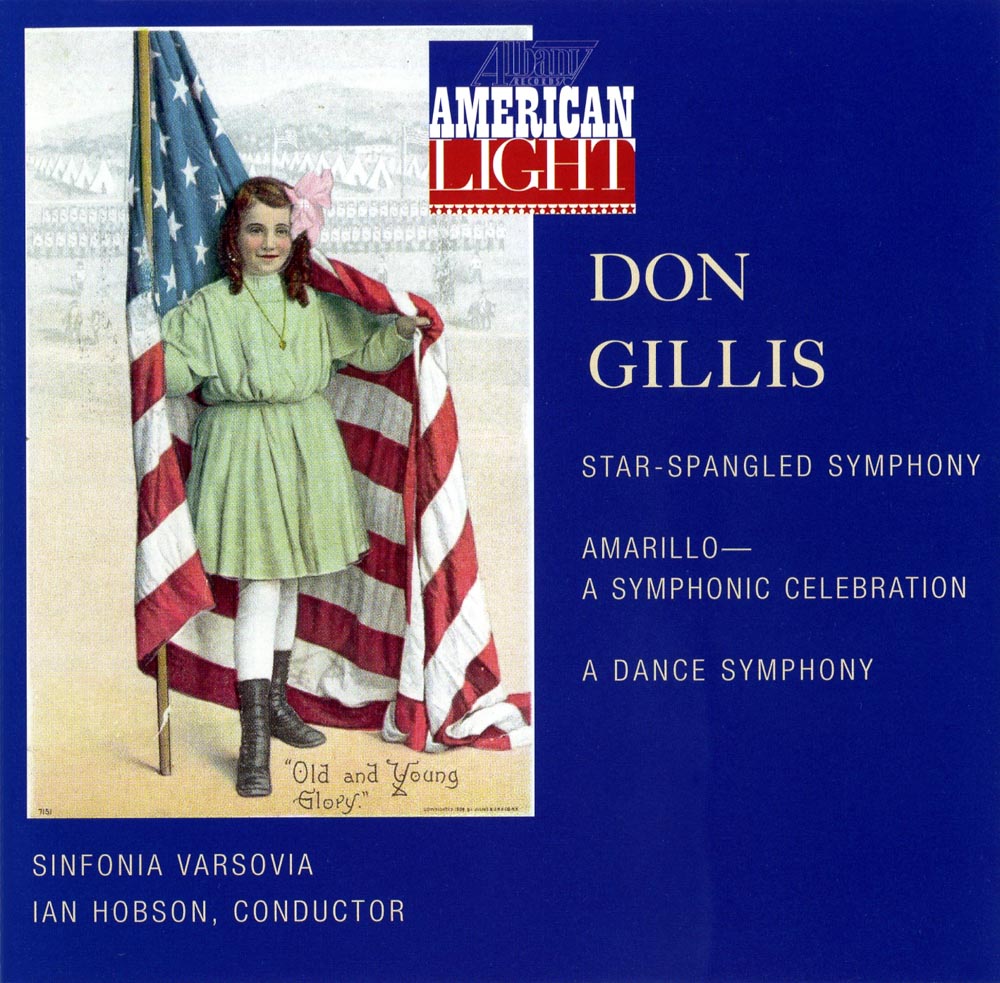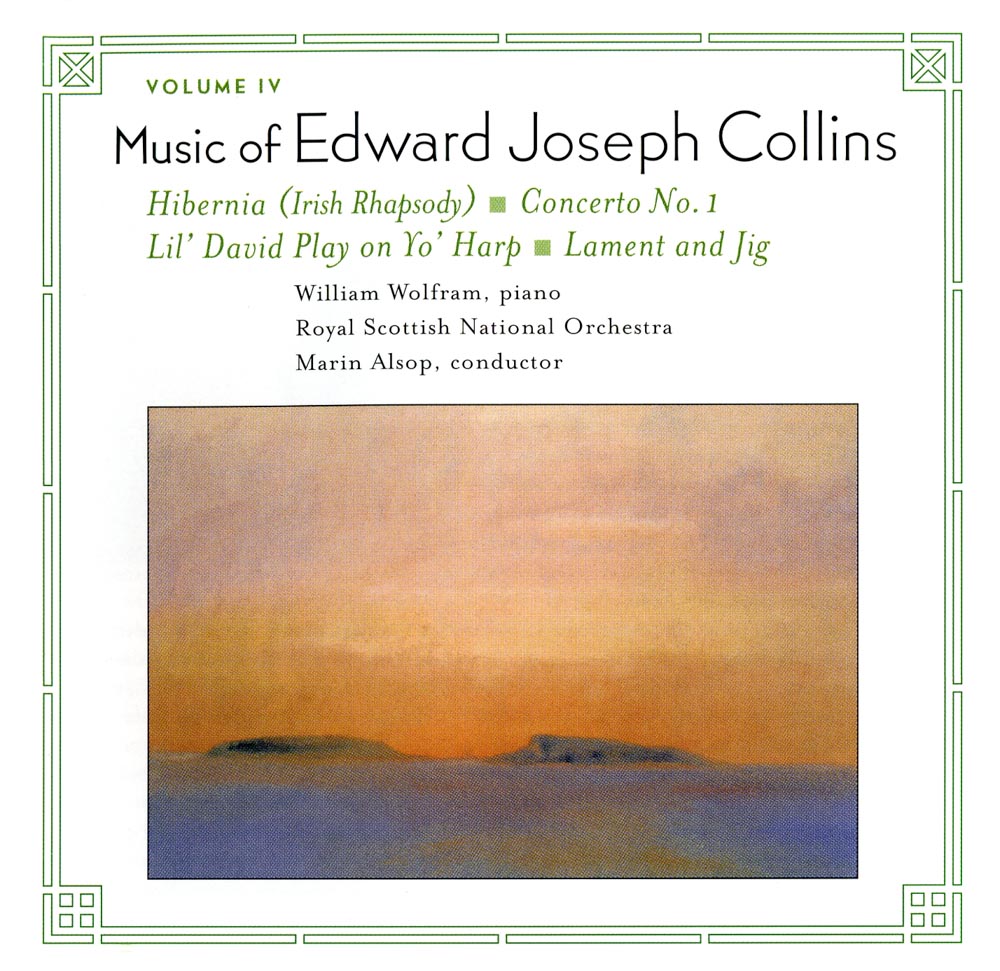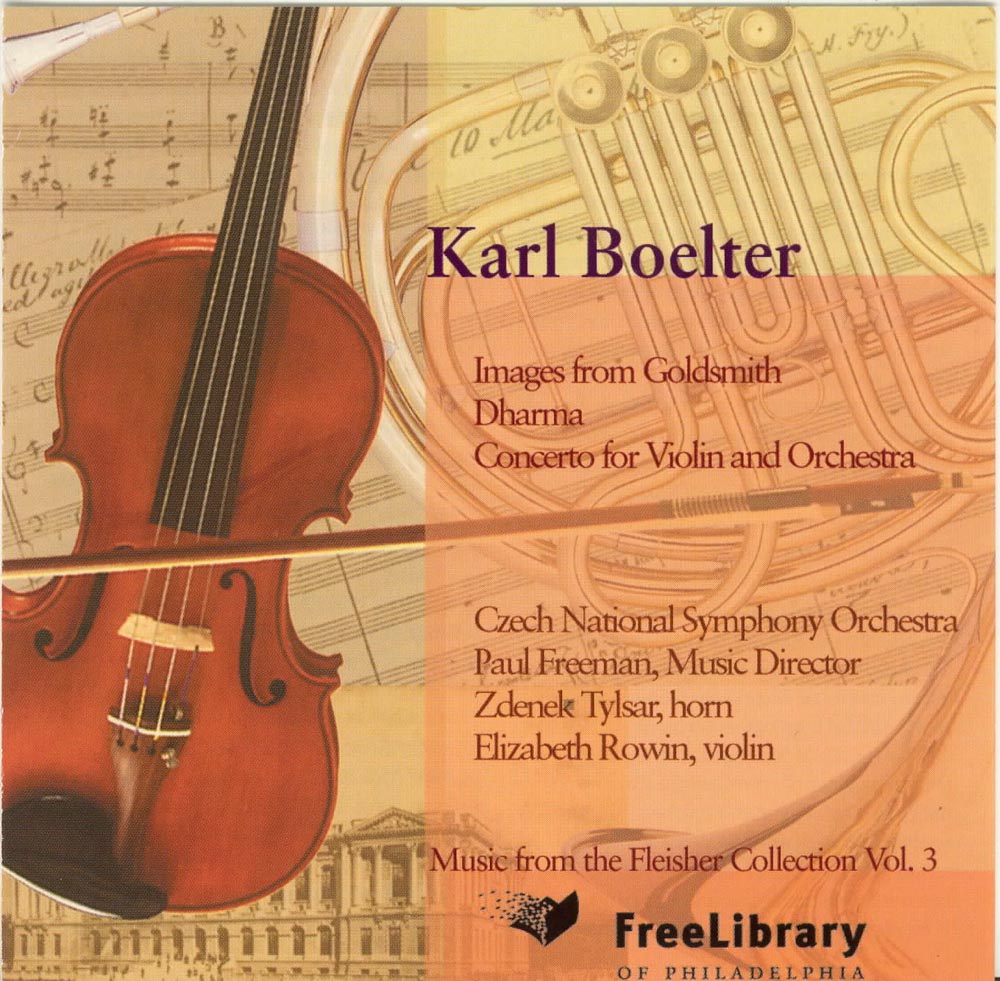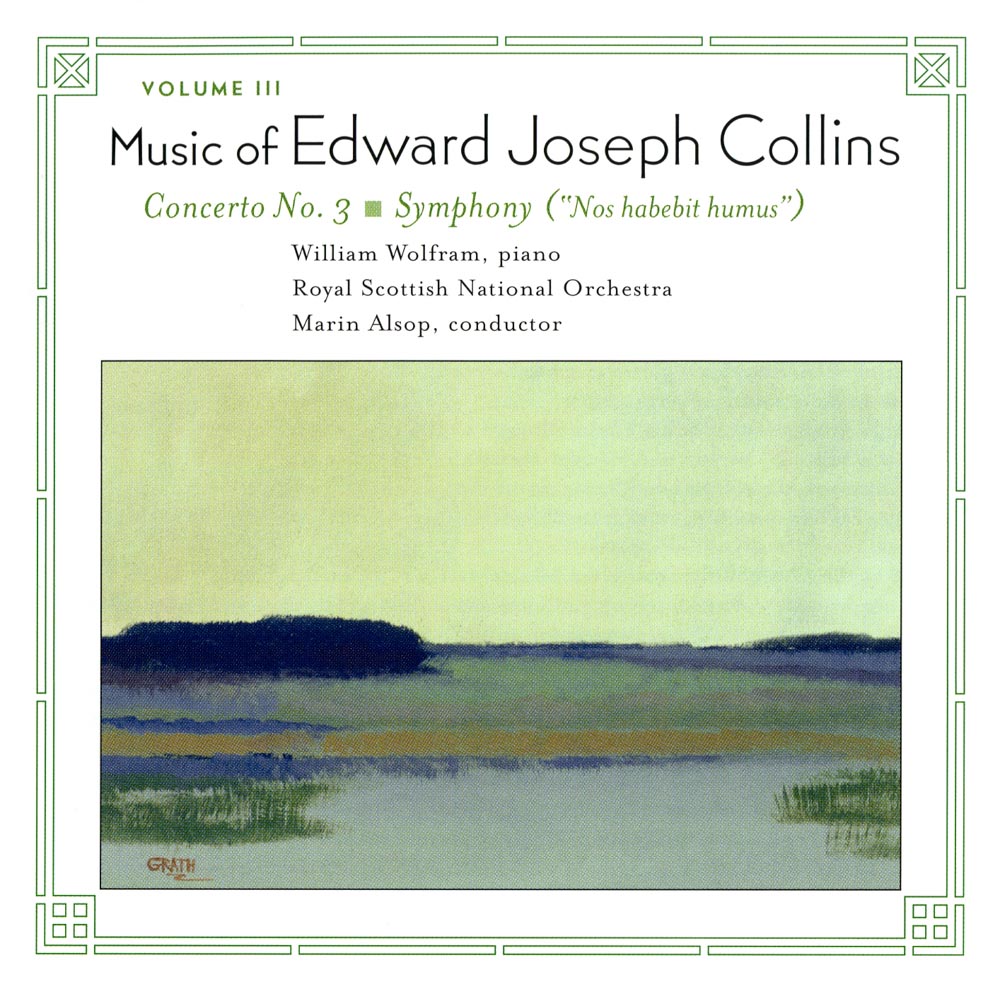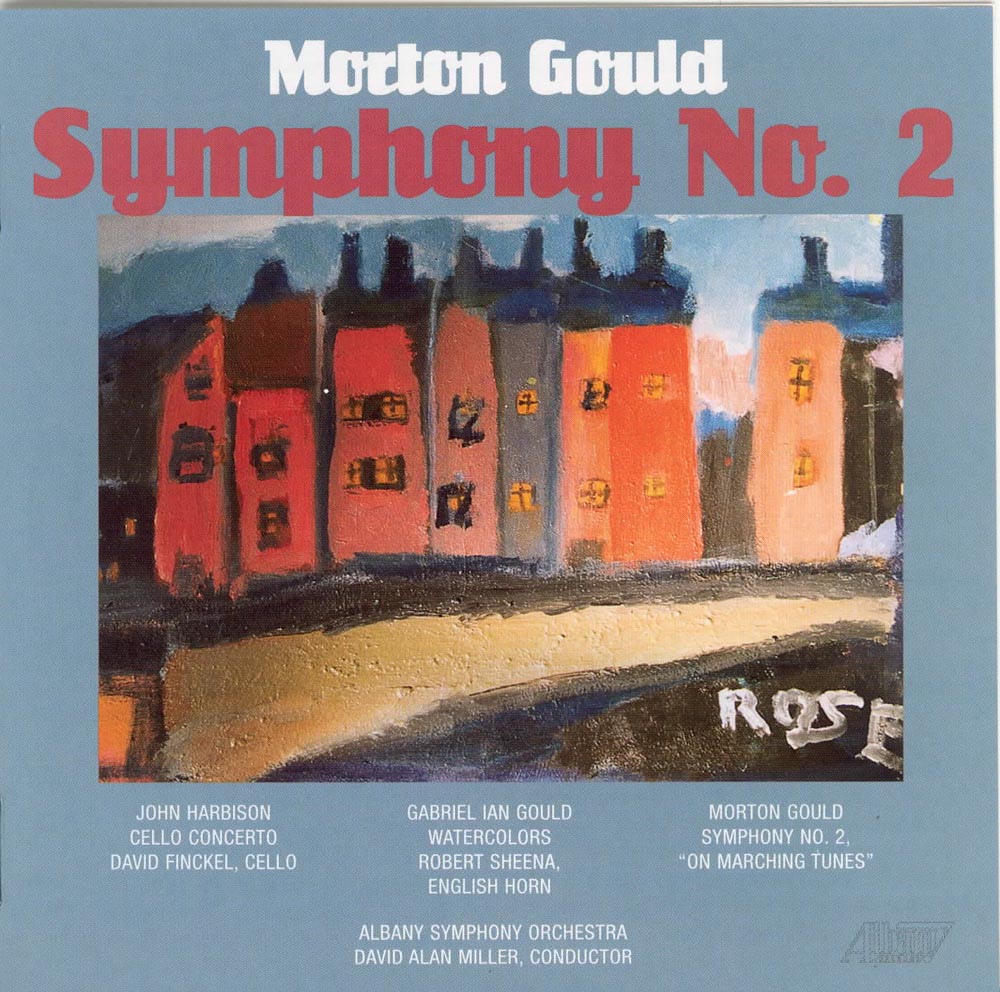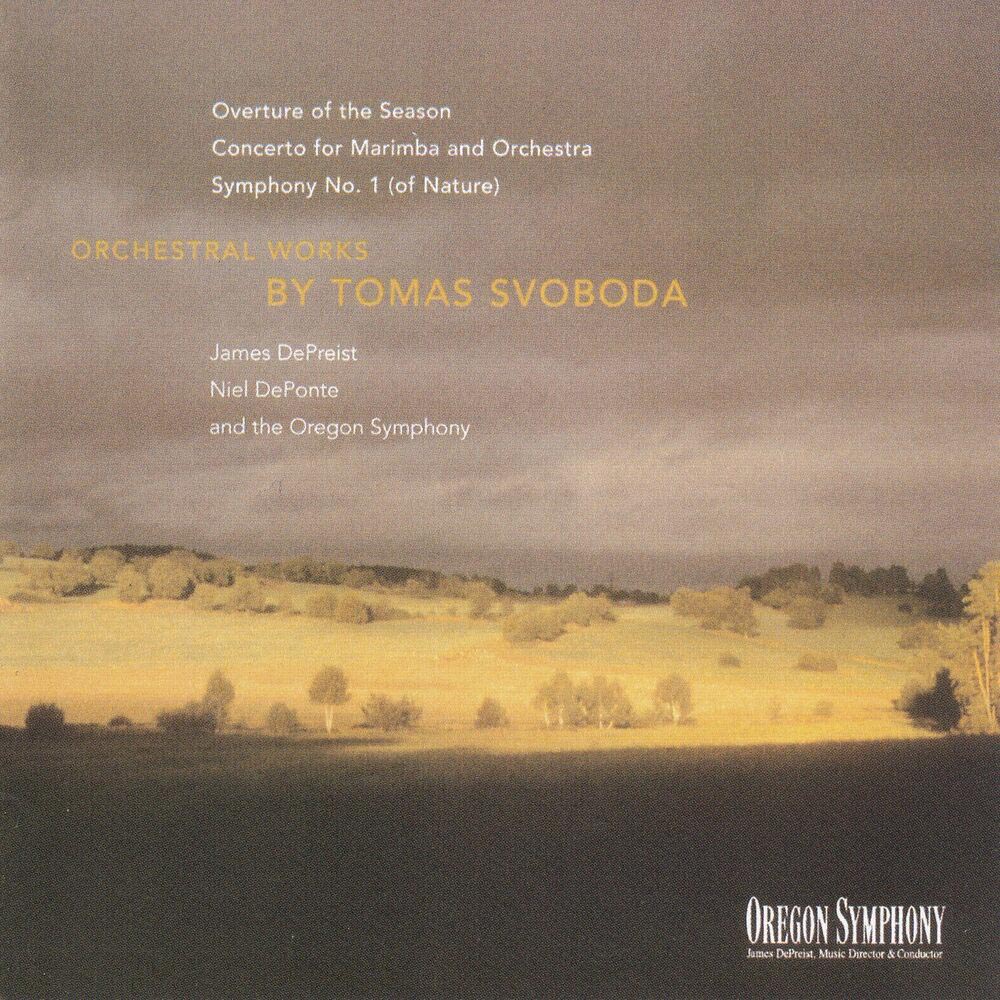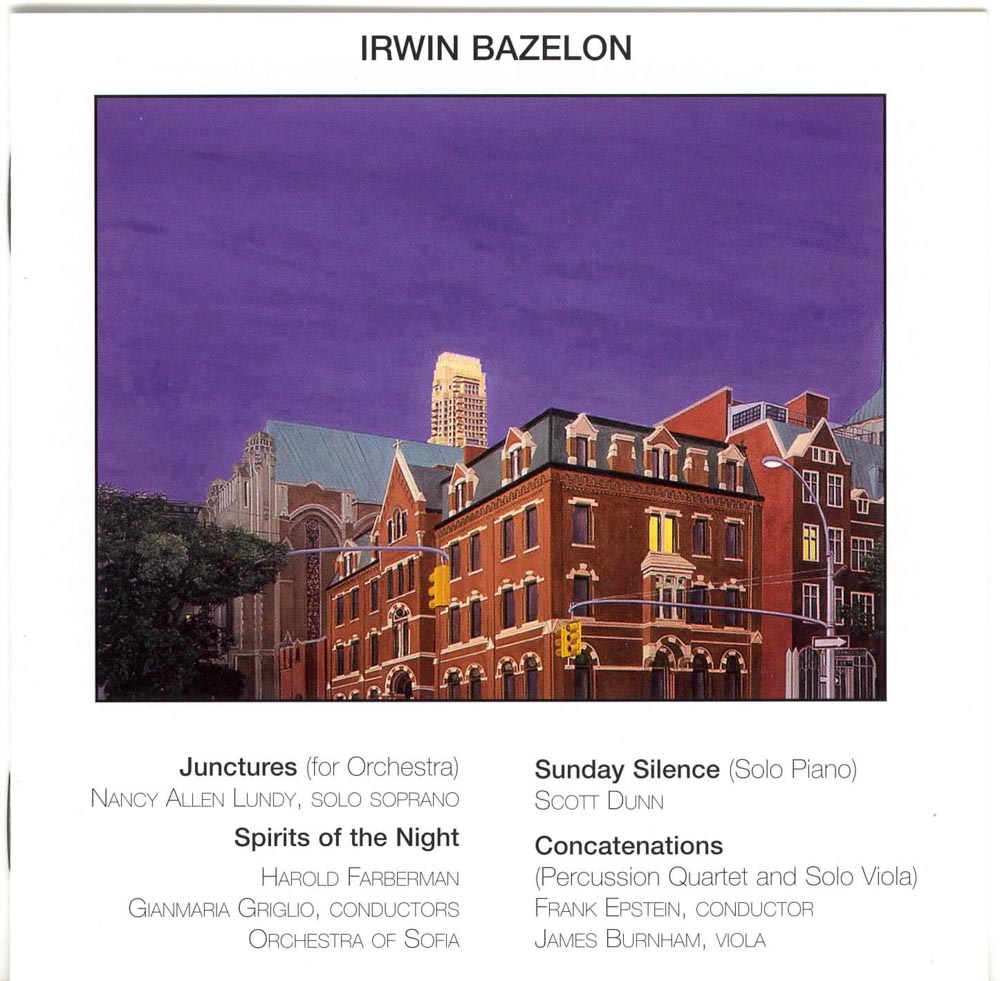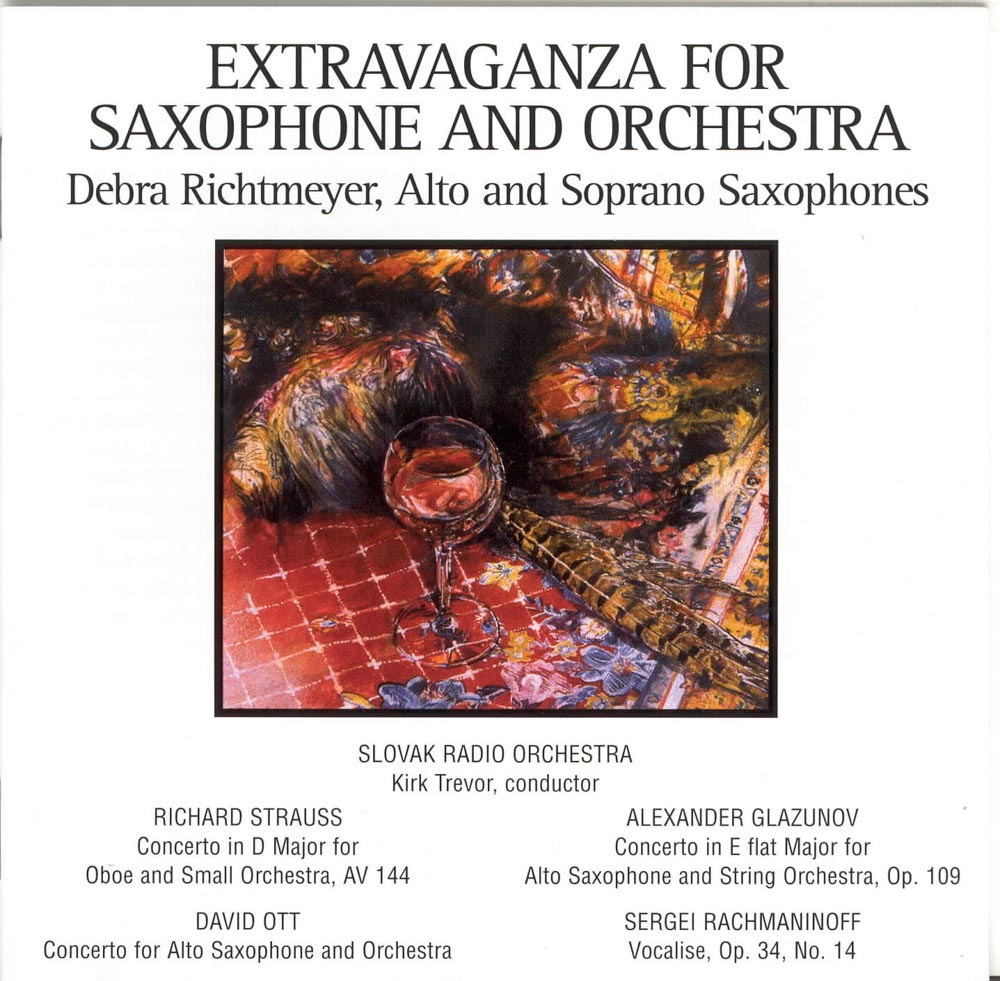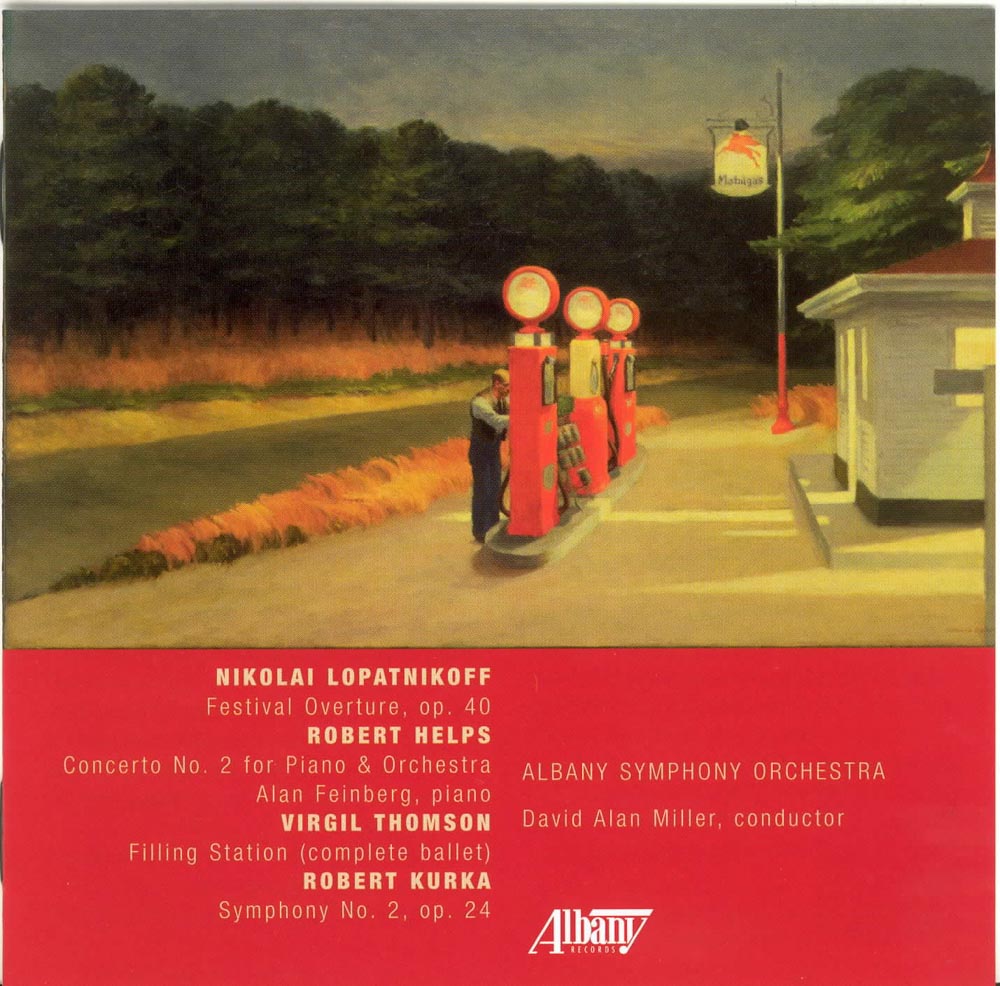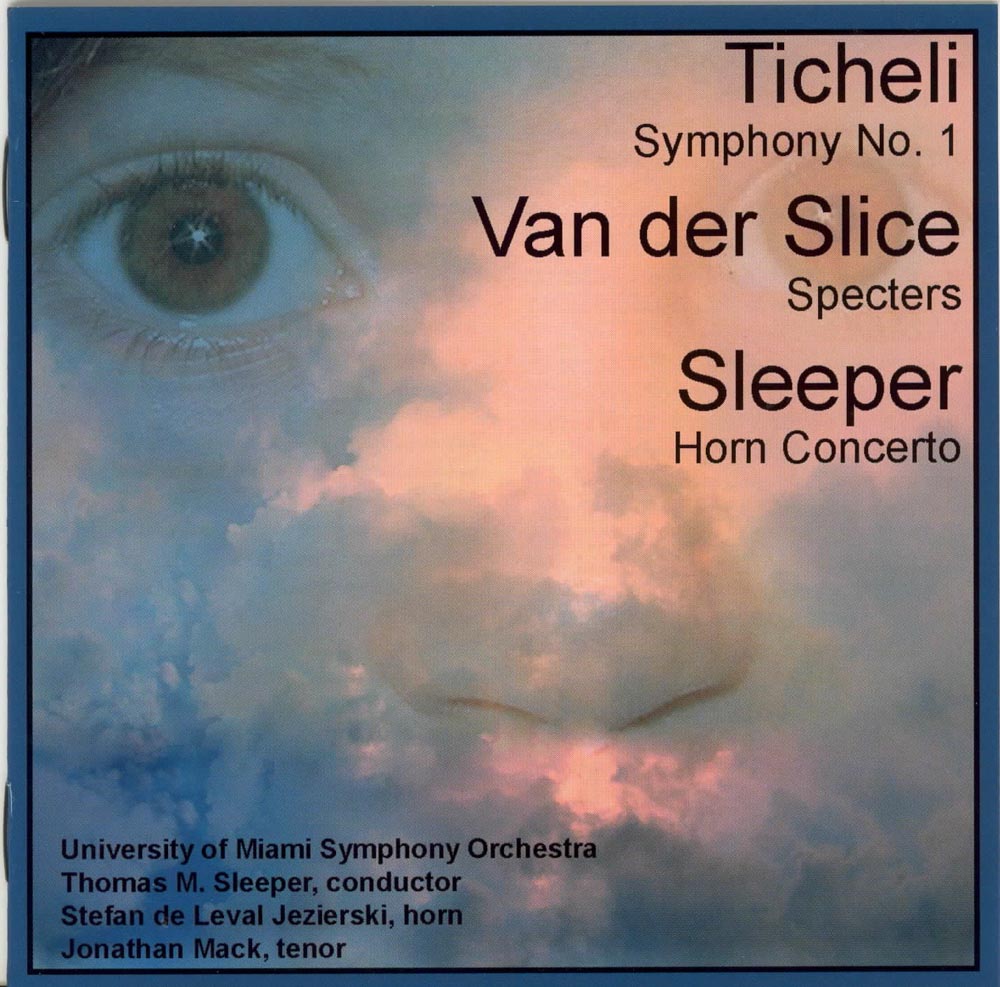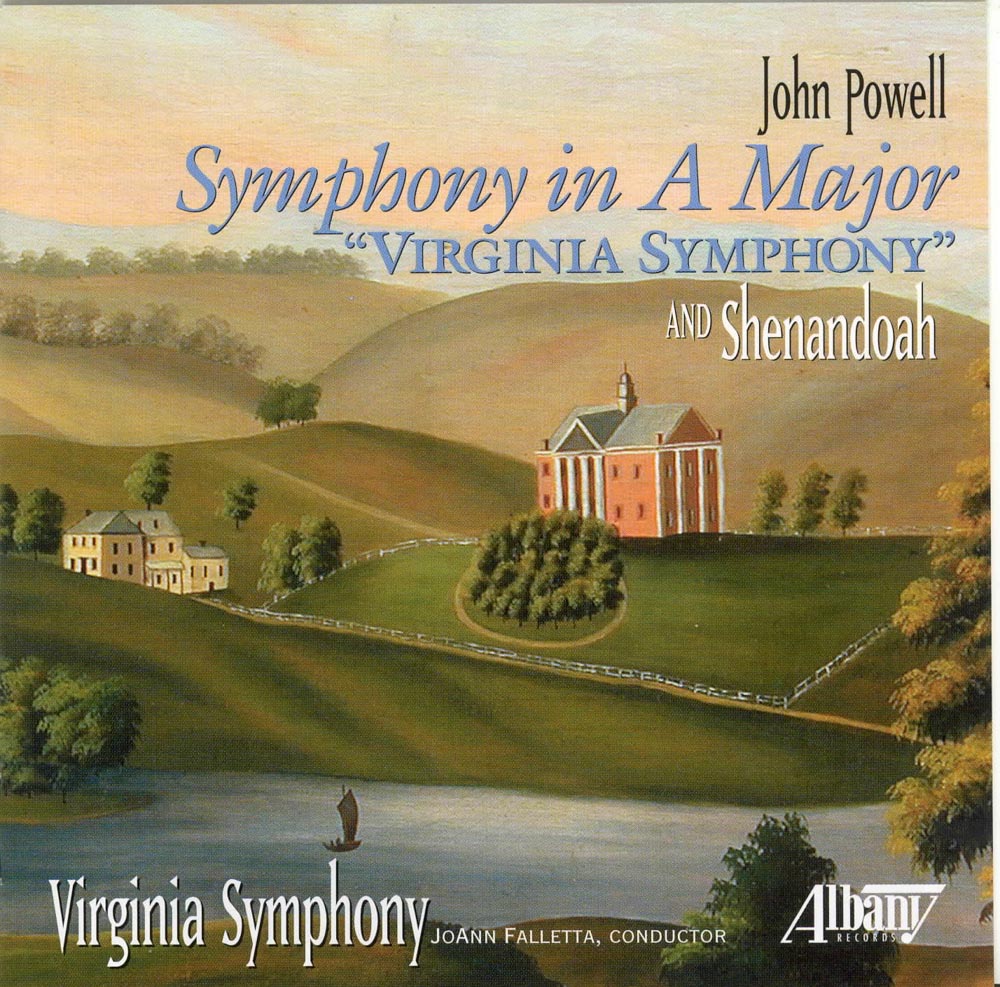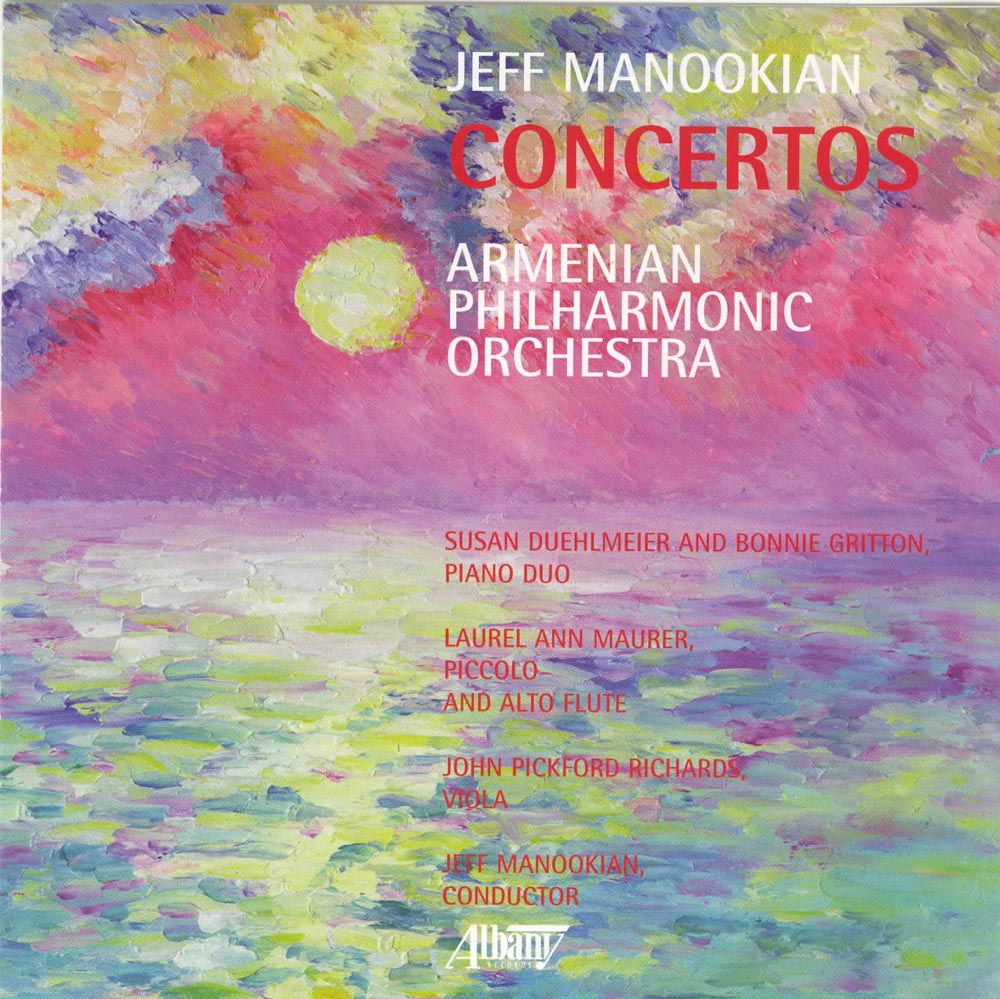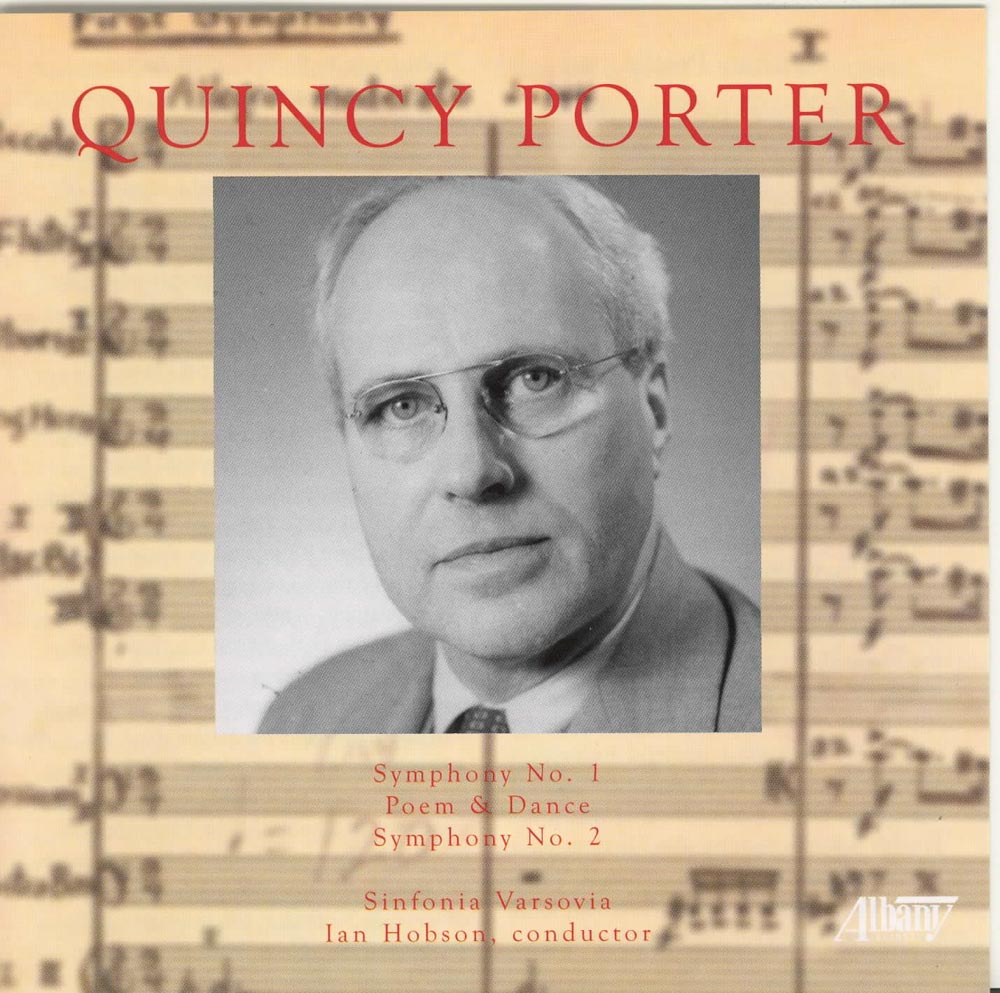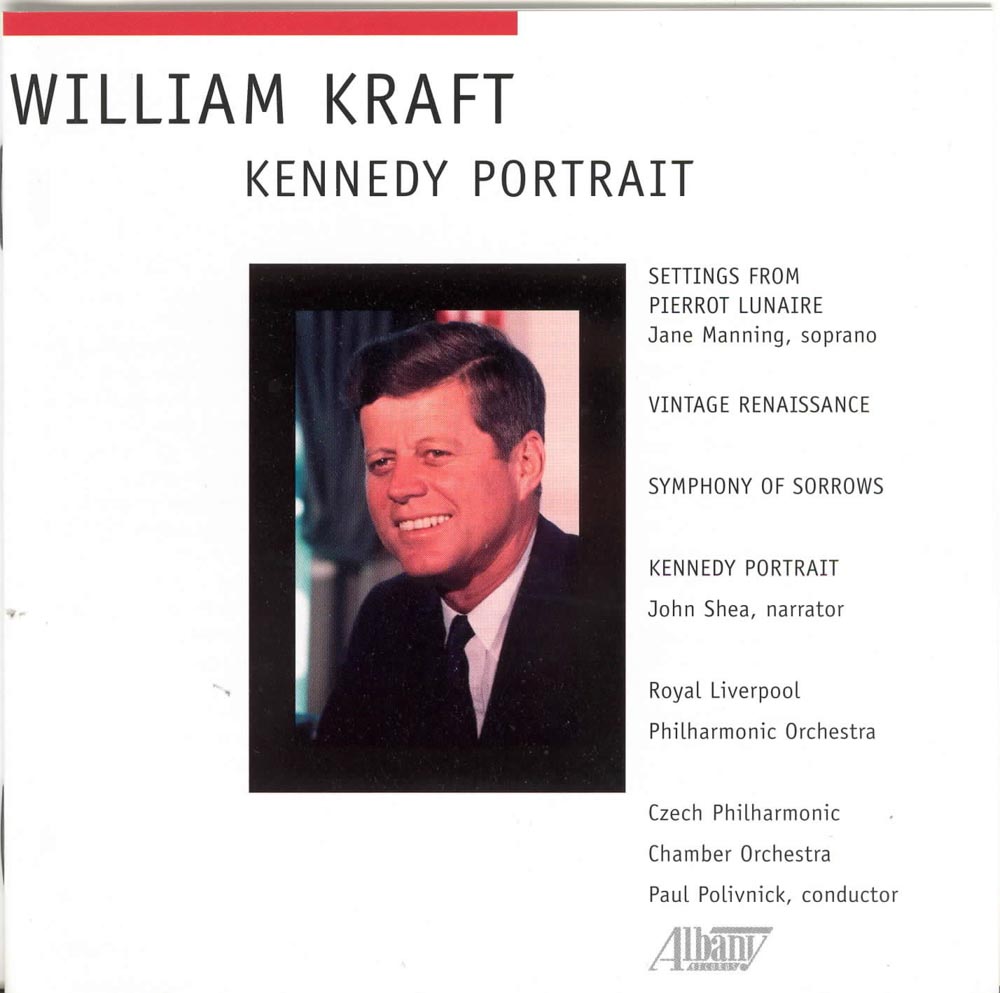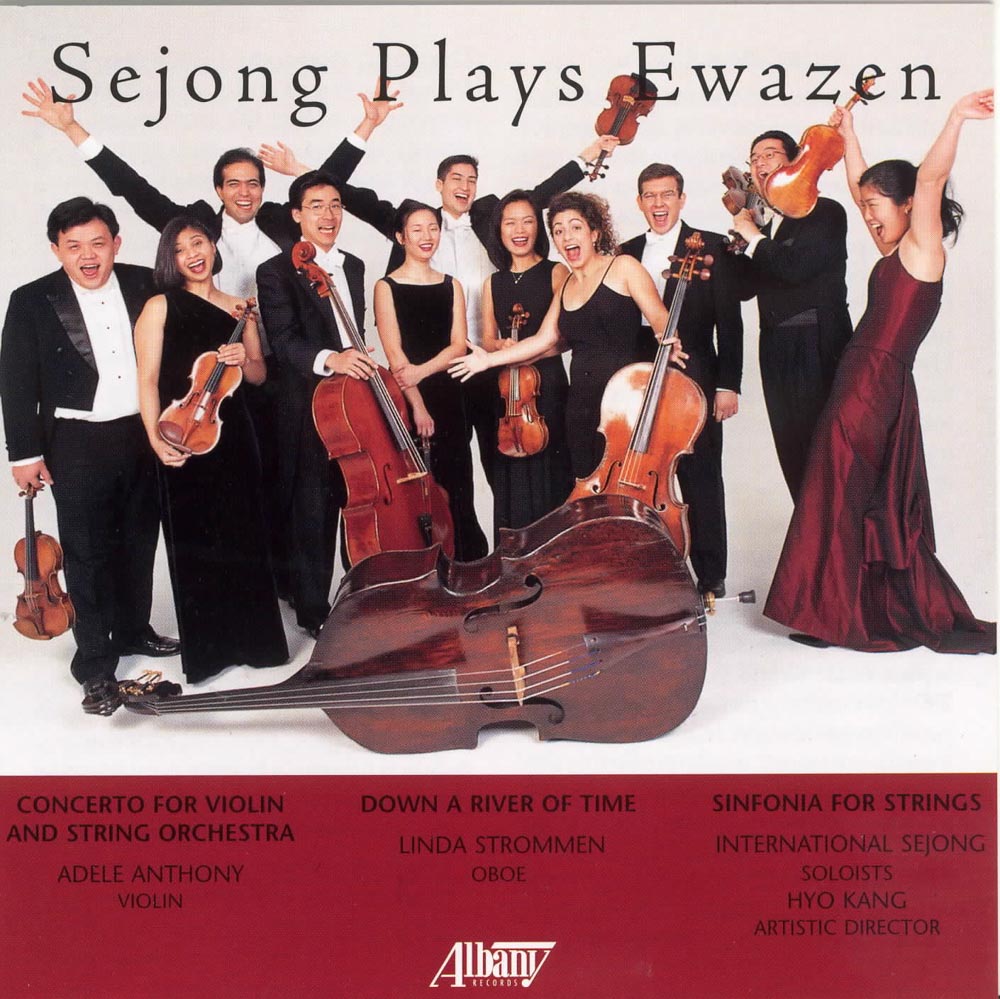Catalog #: TROY0708
Release Date: December 1, 2004OrchestralAngelo Musolino has been an educator for more than 40 years, both as private instructor and as a college professor at the Brooklyn Conservatory of Music, Empire State College and Adelphi University where he directs the Pop Ensemble for which he still writes music.
Catalog #: TROY0706
Release Date: December 1, 2004OrchestralEmma Lou Diemer is a native of Kansas City, Missouri. She received her composition degrees from Yale and Eastman and also studied in Belgium and at Tanglewood. She is professor emeritus at the University of California, Santa Barbara, where she taught from 1971-1991. The Concerto in One Movement for Organ and Chamber Orchestra ("Alaska") was written in May, 1995 for Madeline Schatz and the Arctic Chamber Orchestra, and premiered January, 1996 at the University of Alaska, Fairbanks. The soloist was the composer. Marilyn Mason has had a long association with Leo Sowerby's Classic Concerto for Organ and Strings for she gave the work its European premiere in 1957, and in preparation for this she worked closely with the composer himself. Petr Eben is one of the leading composers of the Czech Republic. He studied at the Prague Academy of Music. In 1955, he took up a teaching post in the History of Music Department at Prague's Charles University. In 1978-79, he was professor of composition at the Royal Northern College of Music Manchester. From 1990, he became professor of composition at the Academy of Performing Arts in Prague and President of the Prague Spring Festival. Of the Organ Concerto No. 2, he writes: "After the first organ concerto, which is more of an extended symphony with a concertante organ part, I wanted this time to write a true concerto for organ and orchestra. One of the problems of an organ concerto is that the organ, unlike all the other solo instruments, has a potential in sound equivalent, or nearly so, to that of the orchestra; in exposing both partners at their full volume, there is a risk of overloading the texture. Therefore, in many cases I have placed both elements on different planes, contrasting them not only in their thematic material, but also in time signature and tempi. Elsewhere, I have divided melody and accompaniment between both partners, so that either the organ or even the orchestra takes the role of a melodic instrument, and the orchestra is often written as a unison voice." William Bolcom dedicated Gospel Preludes, Book IV to Marilyn Mason, who premiered the three hymn-fantasies at the University of Michigan in 1986. The composer writes: This is the last collection of my Gospel Preludes, bringing the total to twelve. Sometimes I Feel Like a Motherless Child was a reaction to the brutal end of Marvin Gaye, whose Motown career went beyond the more or less usual stereotype and whose personal life led to his murder. Sweet Hour of Prayer always has had a febrile intensity for me, and I set it with that mood in mind. The final is a combined fantasy on O Zion Haste and a gospel-influenced 5/4 setting of How Firm a Foundation, which caps the whole series." Bolcom's score stands amidst an impressive pile of 20th century compositions brought to life by the energy and determination of Dr. Mason.
Catalog #: TROY0711
Release Date: November 1, 2004OrchestralTim Page has described Five as "...another in a distinguished series of compositions Wuorinen has written for the cellist Fred Sherry. Dating from 1987, it is the most recent piece on this disc and (to employ, reluctantly, what has become an increasingly noxious code word) probably the most "accessible."" Five was commissioned by the New York City Ballet for their 1988 American Music Festival. Fred Sherry writes: "Five is a cellist's showpiece, a dance, a thrill for the audience, and a beautiful example of Wuorinen's versatility and technique." Michael Steinberg writes: "The Golden Dance was commissioned with the cooperation of the San Francisco Symphony by the Meet the Composer Orchestra Residencies program. It was written for Herbert Blomstedt and the San Francisco Symphony on the occasion of the Orchestra's 75th anniversary. It was completed in May, 1986 and was introduced on September 10, of that year. Wuorinen, who likes to make his titles topical and, if possible, punning, has called this piece for San Francisco The Golden Dance. No need to elaborate on the associations called up by the word 'golden' in California. The other meaning is not obvious, and that is the role played in the design by the golden section, that classical division of a line, thought by the Greeks to yield an aesthetically perfect proportional relationship, where the smaller section is to the larger as the larger is to the whole." The Concerto for Amplified Violin and Orchestra was commissioned by the Fromm Music Foundation for Paul Zukofsky, Michael Tilson Thomas and the Boston Symphony Orchestra. It was composed between June 25, 1971 and April 2, 1972 and premiered at Tanglewood on August 4, 1972. The Concerto is in three movements and is marked by a unique relationship between soloist and orchestra; they are on an equal acoustic footing. The amplification of the soloist enables him to compete with the entire orchestra at full volume. The impact is visceral and immediate.
Catalog #: TROY0686
Release Date: October 1, 2004OrchestralChristopher Gunning was born in Cheltenham, Gloucestershire, but spent his childhood in London. He studied composition, piano and percussion at the Guildhall School of Music and Drama, where his teachers included Edmund Rubbra and Richard Rodney Bennett. For most of his professional life he has composed film and television scores. He currently divides his time between composing for films and television, conducting engagements, and composing his own concert works, the most recent of which was a Saxophone Concerto for John Harle. The composer writes: "I had wanted to write a piano concerto for several years before finally getting to grips with it in 2001. So much contemporary piano music seems to ignore that which I like best - the instrument's ability to sing - and I was interested in doing something which explores the lyrical as well as the percussive qualities of the piano. Storm composed early in 2003 has slow outer sections; apart from those it is pretty noisy and dramatic. It is scored for a large symphony orchestra, and I wrote it shortly after spending some time at the seaside and feeling totally exhilarated by the wind and waves of a violent storm. Symphony No. 1, composed in 2002, continues a process begun a few years previously with my Saxophone Concerto, which was my first concert piece following many years of working in films and TV. It was then that I discovered a penchant for single movement forms which move through many changing emotional moods; I think of them as novels or journeys."
Catalog #: TROY0690
Release Date: September 1, 2004OrchestralDavid Gillingham earned degrees from the University of Wisconsin-Oshkosh and Michigan State University. He has an international reputation for the works he has written for band and percussion. Many of his works are now considered standards in the repertoire. He is currently a Professor of Music at Central Michigan University. Double Star for Solo Clarinet, Solo Piano and Wind Ensemble was commissioned by Gary Green and the University of Miami Wind Ensemble to celebrate the friendship between the composer and the two soloists. The work, therefore, celebrates humanity, especially the goodness and friendship one achieves through music. David Maslanka’s Song Book is a set of pieces that are songlike – that is, intimate and expressive, though not necessarily quiet. “The solo flute feels like a voice to me,” writes the composer. “One which has a complex story to tell, in the form of musical dreams. I have used three chorale melodies in Song Book.” David Maslanka was born in New Bedford, Massachusetts. He attended the Oberlin College Conservatory where he studied composition with Joseph Wood. He spent a year at the Mozarteum in Salzburg and did graduate work in composition at Michigan State University with H. Owen Reed. He has served on the faculties of the State University of New York at Geneseo, Sarah Lawrence College, New York University and Kingsborough College of the City University of New York. He now lives in Missoula, Montana.
Catalog #: TROY0687
Release Date: September 1, 2004OrchestralAndrew List composes music in many different genres including orchestral works, string quartet, vocal, choral music and opera, music for children, solo works and a variety of chamber ensembles. A resident of Boston, Massachusetts, Mr. List is a Professor of Composition and Theory at the Berklee College of Music. Born in St. Louis, Missouri, List is a graduate of the New England Conservatory of Music. He received his doctorate in music composition from Boston University where he studied with Bernard Rands and Nicholas Maw. Lee. T. McQuillan, a resident of Middletown, Connecticut, studied Music Education at Barrington College in Rhode Island and later received his Bachelor of Music in composition from the Hartt School of Music. Arthur Welwood is a Professor of Composition at the Berklee College of Music. Wind Sky Clouds, commissioned by jazz trumpeter Greg Hopkins, was completed in the summer of 2003. The premiere performance took place in Hartford, Connecticut on November 16, 2003, with Hopkins playing the solo trumpet and flugelhorn and Tibor Puszati conducting the Connecticut Valley Chamber Orchestra. The piece is an example of "Third Stream," a phrase first coined by composer Gunther Schuller to describe the fusion of jazz and classical styles and where the crossover from one to another in the course of the piece is blurred and often imperceptible.
Catalog #: TROY0672
Release Date: June 1, 2004OrchestralNeal Gittleman writes: “The Dayton Philharmonic’s Wright Brothers Centennial Commissioning project dates back to 1997. At that point, more than five years before the actual 100th anniversary of Wilbur and Orville’s first successful powered flight, it was already clear that something big was called for. 2003 would also be the Ohio state bicentennial, the orchestra’s seventieth anniversary and the DPO’s first season in the new Benjamin and Marian Schuster Performing Arts Center. Given our commitment to the music of today, a major commissioning effort seemed the way to go, bringing to life four new medium-length pieces addressing the broad theme of the Wright Brothers. How do you do that? Easy. You find fearless composers like Bill Bolcom, Robert Xavier Rodríguez, Mike Schelle and Steve Winteregg and turn them loose. They attacked the challenge with the same vigor as Orville and Wilbur tackled the challenges of powered flight. Technical problems had to be solved. For the Wrights there were issues of wing and propeller design, inventing a control mechanism, finding a light but powerful motor and conquering the multidimensional challenges of lift, yaw and roll. For the composers, there were questions of genre, language, piece-d’occasion – or piece-for-the-ages and “How many percussionists can I have?” In the end, what made both endeavors successful was imagination and inventiveness – the imagination to envision the end result and the inventiveness to make it happen. More than anything else, this CD and the four works it contains reflect the spirit of Wilbur and Orville Wright, the greatest sons of Ohio’s great city of inventors”. Allison Janney, of The West Wing fame, was raised in Oakwood, a small suburb of Dayton. She attended Kenyon College in Ohio and landed a role in a play directed by alumnus Paul Newman. Newman’s wife, Joanne Woodward, encouraged Janney with her acting and suggested that she consider studying at New York’s Neighborhood Playhouse. She has won three Emmy awards for her work in television.
Catalog #: TROY0666
Release Date: May 1, 2004OrchestralThe Massachusetts Wind Orchestra was founded in 1991 by Music Director, Malcolm W. Rowell, Jr., and has captured the attention and participation of some 140 outstanding musicians from throughout the East. This ensemble is now recognized as one of the finest professional ensembles of its kind in the United States. The Massachusetts Wind Orchestra provides quality musical experiences to wind, brass and percussion musicians. Its personnel are professional musicians , educators and freelancers who have trained at many of America's leading conservatories, colleges and universities. The ensemble offers a unique opportunity to experience and explore traditional and contemporary wind music while aspiring to the highest musical standards. It provides an avenue of professional growth for its membership, and its innovative programming honors the heritage of bands while advancing the medium into the 21st century through commissions, premieres and recordings. On September 21, 1997, at Tanglewood's Ozawa Hall, the Massachusetts Wind Orchestra presented the first wind band concert ever heard at Tanglewood.
Catalog #: TROY0662
Release Date: May 1, 2004OrchestralDon Ray was born, reared and educated in Southern California, where he took his B.A. at U.C.L.A. and his M.A. from California State University. He joined the CBS-TV Music Staff in 1956 and remained there as Music Supervisor until retirement in 1986. While there, he composed scores for G.E. Theater, Gunsmoke, Twilight Zone, CBS Movie-of-the-Week, and Hawaii Five-O, the latter bringing an Emmy nomination for best dramatic score. On leaving CBS, he turned to writing concert music. He has also been active in teaching film scoring techniques. His Piano Concerto is in four movements, employs the standard symphony orchestra and lasts about 40 minutes. It was begun in Dublin in 2000 and completed in Los Angeles in 2001. Family Portrait, Suite No. 2 contains a series of character studies and events in the family of the composer's grandparents who homesteaded a farm in the American Northwest around 1900. This suite is drawn from the original work which has thirteen movements.
Catalog #: TROY0657
Release Date: May 1, 2004OrchestralIn his journal of November 7, 1939, Collins briefly notes that he is working on the score of the Ballet-Suite: The Masque of the Red Death. It was not completed until almost fifteen months later, and during that period, Collins often reflected in his journal about death. The passing of a favorite sister prompted him to question the nature of individual mortality. The Ballet-Suite was completed on January 29, 1940. Collins was not entirely pleased with it. In his journal he wrote: "Finished the 'Masque' at five-o-clock. I was terribly sick of it at the end, but I just had to finish it and I fear the Invocation Profane suffered, as it was the final fragment in the order of composition." Submitted as an entry for a competition sponsored by the Saint Louis Symphony Orchestra, Masque also caused its composer some other discomfort. He worried about the reaction of his former teacher and friend Rudolf Ganz. Two days after the completion, he was more positive, noting in his journal that "I wrote the Masque faster than anything in my life". Despite the composer's caveats, the lurid drama of Red Death prompted a vivid score, before which Collins included his synopsis of the story by Edgar Allen Poe (which is included in the program booklet). This CD likely contains the first of several orchestral and piano solo variations on the Irish "potato famine" folksong, O! The Taters they are small over here! On May 21, 1927, Collins's entry in his journal reads, "Only ten more days to complete the 'Irish Rhapsody'. The college orchestra will have difficult time learning the piece by the 20th of June." Students of the Chicago Musical College performed the premiere, conducted by Collins, then a member of the college's faculty. Collins mentions his Set of Four in two journal entries, referring to an Illinois competition that likely involved the Chicago Symphony Orchestra and its conductor Frederick Stock. "May 28, 1925 One day nearer to catastrophe. After hearing the rehearsal this morning I am certain my Set of Four has no chance in Evanston. Lord help me! I am discouraged today and don't know exactly what to do." Despite the competition results, these four short orchestral pieces are typically well-crafted and full of atmosphere.
Catalog #: TROY0648
Release Date: April 1, 2004OrchestralTwo of the three concertos on this recording were composed on commission from New Heritage Music, a publicly supported non-profit organization which promotes the creation of works inspired by persons, events and ideas central to history. Chen Yi and Behzad Ranjbaran feel a particular connection to individuals striving for self-realization, as they were each born in countries where they suffered the lack of the freedoms that Americans hold dear. Both on this basis and artistically, they proved to be ideal choices to create musical works celebrating the adoption of the Universal Declaration of Human Rights by the United Nations (Chen) and the life and thought of Thomas Jefferson (Ranjbaran). According to New Heritage criteria, neither work is intended to be narrative or programmatic; rather, they reflect the artists' creative responses to an event or idea that has personal significance. By contrast, Barber's Cello Concerto was not commissioned with any patriotic or historical intention; yet it can hardly fail to have reflected the intensity and angst of the world situation - the last months of World War II and the first few months of the peace - amidst which it was written, the more so because the composer was wearing the uniform of an American soldier at the time. The three works on this program are thus linked by the struggle for human rights and freedom, experienced through singular, individual life experience of the loss of those rights or through participation, in uniform, in worldwide armed conflict on behalf of those rights. Chen Yi, born in China, experienced first hand the lack of those rights. She is one of several talented Chinese composers to have moved to the United States after having been caught up in the terrors of the Cultural Revolution, with its express intent of suppressing China's intellectual life. She came to the United States in 1986, and studied with Chou Wen-chung and Mario Davidovsky and earned her Doctor of Musical Arts degree at Columbia University in 1993. In 1998, she became Lorena Searcey Cravens/Millsap/Missouri Distinguished Professor in Composition at the Conservatory of the University of Missouri-Kansas City. Behzad Ranjbaran began his musical studies early when he entered the Tehran Music Conservatory at the age of nine. Following his graduation, he came to the United States as a young violinist to continue his studies at Indiana University, with composition as a secondary major. He went to Juilliard for a doctorate in composition. His teachers were David Diamond, Vincent Persichetti and Joseph Schwantner. He has remained on the Juilliard faculty ever since.
Catalog #: TROY0646
Release Date: March 1, 2004OrchestralElliott Schwartz was born in New York City and studied composition with Otto Luening and Jack Beeson at Columbia University. Since 1964, he has taught at Bowdoin College, where he is currently the Robert K. Beckwith Professor of music. There are five orchestral works on this disc which share a number of traits - in particular, a fondness for bright, splashy instrumental colors, multi-layered textures (akin to photographic "multiple exposure"), eclectic style juxtapositions, and references to pre-existent music of the past. Many of the principal motives are derived from patterns - number sequences, or musical spellings - which are related to extra-musical programmatic sources. Moreover, these pitch patterns often expand into twelve-tone rows (which in turn generate new patterns). The musical surfaces, however, are far removed from the world of strict serialism. Quite the opposite, in fact: tonal, triadic passages and angular, dissonant ones jostle each other, and controlled improvisation often flows through and around strictly notated narrative. Finally, a distinctly "theatrical" strain runs through these compositions. Performers may be asked to walk or speak; orchestra choirs - the wind section, or the brasses (appropriately at the rear of the stage), may play "competing music" - fragments of pre-existing material - at odds with the prevailing music that surrounds them. Unusual instruments - metronomes, police whistles, flashlights, or piano interiors - may be employed by the players. These are intended to create a multi-dimensional, and perhaps even dream-like, experience.
Catalog #: TROY0635
Release Date: March 1, 2004OrchestralJohn Biggs was born in Los Angeles, the eighth of 11 children. His father was organist-composer Richard Keys Biggs and his mother was singer-conductor Lucienne Gourdon. During his youth he received training in acting, singing, piano, bassoon, and violin, and was a member of his father's church choir. He received his Masters Degree in composition from the University of California at Los Angeles, with further study at the University of Southern California and the Royal Flemish Academy in Antwerp, Belgium. His teachers were Roy Harris, Lukas Foss, Ingolf Dahl, Flor Peeters, and Halsey Stevens. "I received a Fulbright Grant in 1964 to study composition with Flor Peeters at the Royal Conservatory of Music in Antwerp, Belgium. I was 32, and eager to write a large work. I used October, November, and the first part of December to write the symphony. The premiere of the work took place on May 15, 1965, with me conducting the Antwerp Philharmonic. My Symphony No. 2 was commissioned by the York Symphony of York, Pennsylvania and premiered on April 26, 1992, with Robert Hart Baker conducting. While attending a concert at the University of Southern California in 1958, I heard a composition by Halsey Stevens based on the epic poem The Ballad of William Sycamore by Stephen Vincent Benet. I was so moved by the music, and especially by the text, that I decided I would someday set the very same poem. The opportunity came 36 years later, when I was commissioned by the New West Symphony of Ventura County, California, to compose a piece for the opening of their inaugural season. The premiere took place on October 6th and 7th , 1995. The conductor was Boris Brott, and the narrator was Michael Gallup."
Catalog #: TROY0633
Release Date: March 1, 2004OrchestralAbout her piece blue cathedral Jennifer Higdon writes: "Blue...like the sky. Where all possibilities soar. Cathedrals...a place of thought, growth, spiritual expression...serving as a symbolic doorway into and out of this world. Cathedrals represent a place of beginnings, endings, solitude, fellowship, contemplation, knowledge and growth. These were my thoughts when the Curtis Institute of Music (where she teaches) commissioned me to write a work to commemorate its 75th anniversary. Curtis is a house of knowledge - a place to reach towards that beautiful expression of the soul which comes through music. Coming to the writing of this piece at a unique juncture in my life, I found myself pondering the question of what makes a life. The recent loss of my younger brother, Andrew Blue, made me reflect on the amazing journeys that we all make, especially at Curtis, where the pursuit of "the singing soul" is what music and life are all about. This piece represents the expression of the individual and the whole of the group...our journeys and the places our souls carry us." Braxton Blake studied composition with Samuel Adler, Warren Benson and Joseph Schwantner at Eastman, where he also served as director of the school's Musica Nova ensemble. He has also studied at the Bayreuth Festival, the Dartington Festival and the Staatliche Musikhochschule in Stuttgart, Germany. "In composing these songs, I decided to mirror the directness of Dorothy Parker's poetry in my music. I enjoy composing in a variety of styles, and it seemed appropriate to borrow just a bit from Parker's era, as will be immediately clear to the listener. These songs are cabaret songs - though not specifically meant for a cabaret. Like many cabaret songs, they are narrative scenes, all with contrasting music." Daniel S. Godfrey earned bachelor's and master's degrees in composition from Yale University and a Ph.D from the University of Iowa. He is professor of music in the Setnor School of Music at Syracuse University and has held visiting faculty appointments at the Indiana University School of Music, the Eastman School of Music and the University of Pittsburgh. "Lightscape was commissioned for and premiered by the Syracuse Symphony Orchestra in 1997. The idea of light in this work is abstract, having as much to do with 'inner' as outer light. The concluding measures, however, do have an external source: the deep glow and fade of sunsets among the islands of the mid-coast Maine. The high-point of the piece reflects a line in the Rig Veda (with which the score is inscribed): "May we soar like birds, far beyond the sun, blazing with Thy light." About his Tuba Concerto John Williams writes: "I really don't know why I wrote it - just urge and instinct. I've always liked the tuba and even used to play it a little. I wrote a big tuba solo for a Dick Van Dyke movie called Fitzwilly and ever since I've kept composing for it - it's such an agile instrument, like a huge cornet. I've also put passages in for some of my pets in the orchestra - solos for the flute and English horn, for the horn quartet and a trio of trumpets. It's light and tuneful and I hope it has enough events in it to make it fun."
Catalog #: TROY0638
Release Date: February 1, 2004OrchestralSymphony No. 2: Earth, Fire, Air, Water for soprano, mezzo-soprano, men's chorus and orchestra is based on a text drawn from the words of North American Indians from the 17th to the 20th century. They speak of "the sacred earth," "the blessings of the great mystery," "their love of this beautiful land" filled with "singing birds and sacred trees," "spring," being "born free where the wind blew free and everything drew a free breath, accepting the kinship of all creatures and unity with the universe." Their voices also speak about being "destroyed by swords and guns," their "people scattered, gone," "the tree withered," their being reduced to a shadow without a voice. Their voices speak to us today. The symphony is divided into four contrasting movements, the structure of each determined by the text. The first performance took place in the Cathedral of St. John the Divine in New York City. The work was revised in 2000. About his Symphony No. 7, James Yannatos has written: "I think of Symphonies as a circle of sound that celebrates the richness and complexity of life to its natural culmination in death. It is divided into four large contrasting movements that could be titles The many aspects of God, Sanctity of Nature, the Glory of music, and, The Varied life of mankind. The text speaks in many tongues that relate to the spiritual journey of mankind."
Catalog #: TROY0598
Release Date: December 1, 2003OrchestralSteve Margoshes is the composer of the international hit musical Fame. The inspirational musical about New York City's High School of Performing Arts (written with lyricist Jacques Levy) has been performed on every continent in the world in many languages. This CD continues Steve's collaboration with Fame creator, David De Silva, to produce a new body of work for symphony orchestra. He has composed and orchestrated these "symphonic pop" pieces under the banner Symphonic Fame. Steve's work as an orchestrator in the theater includes The Who's Tommy, Smokey Joe's CafT (the songs of Leiber and Stoller), the Elton John/Tim Rice musical, Aida, and the Boy George musical, Taboo. The Romantic Suite from Fame - The Musical features the lyric and ballad side of Fame. The Dream Symphony (for piano and orchestra) is inspired by the idea of a youthful dance company performing a contemporary version of Shakespeare's A Midsummer Night's Dream. Ballade for Trumpet is an uplifting and romantic melody developed in a free-form style. It is performed by Gyorgy Geiger, Hungary's most respected trumpet soloist. This is Forever is inspired by Mildred Cram's novella, Forever (1935). In Search of Hidden Treasure is a Symphonic Adventure inspired by Paolo Coelho's enchanting novel, The Alchemist.
Catalog #: TROY0618
Release Date: November 1, 2003OrchestralFor those of us involved in Albany Records, we feel that the music of Don Gillis is really "cross-over" music - music that can indeed make the interested listener cross-over to our side of the street where those of us are found who enjoy "serious" classical music. Real "cross-over" classical music is music that can be enjoyed by all who love serious music. There ARE many sides to classical music: Schoenberg and Charles Wuorinen are one side, Beethoven and Brahms are another and Don Gillis is another. They ALL can be loved by the serious listener! American Light represents music by composers we feel are legitimate composers of lighter music or music that will appeal immediately to a larger audience. Don Gillis knew the craft. He could make an orchestra sound as good as anyone. Toscanini knew this. This is why he hired him as the arranger for his NBC Orchestra. He could create memorable tunes with the best of them; tunes that would stick with you in your mind; tunes you would want to hear over and over again. And Gillis had his own unique character more so than so many other composers. You hear a piece of music by Gillis, you know it is by Gillis from almost the first measure. Actually, this is the second volume of the music of Don Gillis on Albany Records. Volume 1 is on Albany (TROY391) and is conducted by David Alan Miller with the Albany Symphony Orchestra. If you know that volume than you know what to expect from Gillis' music. If you do not, get this volume and go back and get the first one. Happily, here is music that is infectious, music that truly belongs to the "cross-over" genre in the best sense of the word.
Catalog #: TROY0630
Release Date: October 1, 2003OrchestralThis is the third release on Albany Records of the music of Edward Collins. (Irish Rhapsody) from 1929, is the fullest realization of Collins's thoughts on the Irish folksong "O! The Taters they are small over here!" a tune he used in several compositions between 1927 and 1932. In Hibernia, the composer's imagination, his gift for orchestral tone painting and his ability to establish a reflective mood are lovingly in evidence. No doubt Collins's Irish heritage manifested itself, permeating the nineteen-minute work with an atmospheric mixture of gaiety and wistful melancholy. While it reflects all the technical facility Collins had gained from his musical training, it is the antithesis of an academic piece. It is scored for a large orchestra. Considering Collins's training in composition and success as a concert pianist, his urge early on to tackle a piano concerto was not surprising. Ultimately, Collins wrote three concerti, manifesting growing assurance as a composer with numbers two and three. The first, which William Wolfram describes as a "pastoral" work, came before stylistic influences had jelled into something more personal. The first performance took place in December, 1924 under Frederick Stock and the Chicago Symphony Orchestra with the composer as soloist. On November 18, 1940, Collins reminisced in his journal somewhat enviously about his friend Alfred Wallenstein. Once a section cellist in the Chicago Symphony, "Wally" was invited by Toscanini to audition for the solo cello position with the New York Philharmonic. Collins wistfully remarks that his friend "took the job and shook the dust of Chicago from his shoes." Collins went on to note that Wallenstein later became music director of New York City's WOR radio station and then conductor of several concerts immediately following the Toscanini series. In the same journal entry, Collins wrote: "Wally asked me to make some arrangements for him and I intend to begin with 'Li'l David." The work heard on this recording was completed in 1940. Submitted by Collins in response to a Chicago Symphony Orchestra commission on the occasion of its Golden Jubilee, Lament and Jig was the sixth of a set of twelve variations written by a dozen different composers under the collective title, Variations on an American Folk-Song. Other composers included Leo Sowerby, John Alden Carpenter and Rudolf Ganz. The theme was "El-A-Noy, an Illinois pioneer recruitment song, perhaps selected by Frederick Stock who conducted the premiere on April 17, 1941.
Catalog #: TROY0594
Release Date: October 1, 2003OrchestralKarl Boelter's music ranges from contemplative to visceral, from serious to playful. He was born in Milwaukee and studied composition at Ball State and the University of Michigan. He has studied with William Bolcom, Leslie Bassett and William Albright. For several years, he resided in Atlanta where he served as music curator at the High Museum of Art. This experience provided direct involvement with performances by some of the 20th century's greatest artists as well as a personal exploration into the diversity of artistic expression: classic blues and jazz, Cajun two-steps, the music of Africa, and Cowboy poetry. Dr. Boelter is professor of music composition at Oakland University, Rochester, Michigan, where he currently serves as Chair of the Department of Music, Theater and Dance.
Catalog #: TROY0625
Release Date: September 1, 2003OrchestralEdward Joseph Collins was born in Joliet, Illinois and was the youngest of nine children all of whom were musical. He studied first in Chicago with Rudolf Ganz and then in Berlin with Max Bruch and Engelbert Humperdinck, among others. He returned to the United States in the fall of 1912 and began to concertize. During 1913/14, he was appointed assistant conductor of the Century Opera Company in New York. In 1914, he traveled once again to Europe where he was engaged as an assistant conductor at the Bayreuth Festival, where his duties also included playing the timpani. In August 1914, the outbreak of hostilities in Europe necessitated his return to America. When the U.S. entered the War, he began as an infantry private, but soon rose to the rank of Lieutenant. When Collins returned to Chicago, he resumed his performing career and married a young voice student named Frieda Mayer whose father was Oscar Mayer, the owner of the Chicago Meat Packing Company that bears his name. Erik Eriksson, Collins' biographer has written: "The music of Edward Joseph Collins deserves closer attention and more frequent performance. Collins was highly original in his organization and employment of ideas, in the flow with which they were assembled, and in the unforced introduction of American idioms to works that were conceived with great seriousness of purpose. With strength of character and courage that must be admired, Collins composed music that also exhibits an endearing capacity to convey genuine and enduring emotion." See also TROY267 for more of Collin's music.
Catalog #: TROY0605
Release Date: September 1, 2003OrchestralSteven Stucky was half-finished with a brief work for large orchestra before deciding on the French term son et lumiere for his title. Meaning "sound and light," the coinage originated in Chambord in the early 1950s to refer to outdoor evening spectacles that featured brilliant lighting effects and recorded music as the background for talks about historical buildings. In Stucky"s resulting "orchestral entertainment whose subject is the play of colors, bright surfaces and shimmery textures," the composer explains that his aim was to "recapture the Tlan and immediacy that regular meters and repetitive rhythms make possible." Today, Stucky is professor of composition and director of the new music group, Ensemble X, at Cornell. A short, highly evocative - almost mystical - work for solo English horn and chamber orchestra, "Watercolors is not about the substance of water," says the composer Gabriel Ian Gould, "as much as it is about our perception of water. It also has very little to do with watercolor painting, as the title might suggest, although there is something in this piece of the technique's soft edges and blended colors. I have attempted to represent not water itself, but rather its fluid qualities of refraction and reflection, opacity and translucence, lightness, darkness and the myriad shades and tones in between." This work won Gould his second BMI Student Composer Award. John Harbison's Cello Concerto was commissioned by the Boston Symphony Orchestra and the Chicago Symphony Orchestra. Scored for large orchestra, it features an especially varied percussion section, with an array of pitched and unpitched gongs suggestive of the sort of East Asian ensemble called a gamelan. Dedicated to and premiered by cellist Yo-Yo Ma, it debuted in Boston on April 7, 1994, with Seiji Ozawa conducting the Boston Symphony Orchestra. These first performers, according to the composer, considerably determined the concerto's character and flavor. Harbison notes that the three connected movements "all move without warning between slow and fast, expressive and virtuosic, domestic and exotic. These moods are connected by the solo cello line, which rises from the East, eventually to descend, refracted, in the West." Almost joltingly catchy, straightforward and down-to-earth after the light sensitive works of this disc's other composers, Morton Gould's Symphony No. 2 (the handwritten score gives two subtitles: "On Marching Tunes" and "Symphony on Marching Tunes") was commissioned by the Young Men's Christian Association for its hundredth anniversary and dedicated to "the Freedom-loving Youth of the World." The premiere took place during a radio broadcast by the New York Philharmonic, under Vladimir Golschmann, on June 4, 1944. An anecdote, courtesy of Gould's biographer, Peter Goodman, attaches to that first (and apparently, before the Albany Symphony Orchestra's 1999 concert, the only) performance of the complete work: Golschmann had scheduled a rehearsal of the symphony the day before broadcast and asked Gould whether he planned to attend. The composer - known for his unrelenting work ethic - surprisingly said no, claiming some pressing engagement about whose nature he was surprisingly tight lipped. After the broadcast, Golschmann met the composer at the Russian Tea Room, where Gould introduced him to his companion, his wife Shirley. "I had no idea you were married!" the conductor said. "When was the wedding?" "Yesterday," said Gould. The timing of the premiere is also interesting on the level of global, not just intimate, affairs. Two days later, in the climactic military thrust of World War Two's European theater, Allied forces would invade Normandy. This led ultimately to victory, but victory built on a mound of many, many lives. The structuring of Gould's symphony may be reflective of the true cost of triumph.
Catalog #: TROY0604
Release Date: September 1, 2003OrchestralBorn in Paris of Czech parents, Tomas Svoboda spent the years of World War II in Boston where he began his musical education on the piano. Showing a early talent for composing, Svoboda completed his first opus, now published, at the age of 9. After his family's return to Prague in 1946, he continued his music studies entering the Prague Conservatory in 1954 as its youngest student. The premiere of the First Symphony (recorded on this CD) in 1957, performed by the Prague Symphony Orchestra conducted by Vaclav Smetacek, caused a sensation, for until Svoboda walked onto the stage to acknowledge the applause, many in the audience had not realized the 36-minute symphony had been composed by a 16 year old boy not yet even formally schooled in composition or orchestration. In 1962, after graduating from the Prague Conservatory with degrees in percussion, composition and conducting, Svoboda entered the Academy of Music in Prague. By this time, performances and radio broadcasts of his orchestral works had brought him national recognition, clearly establishing him as one of the finest young composers of his generation. In 1964, his family escaped communist-ruled Czechoslovakia and settled in the United States where Svoboda enrolled in the University of Southern California as a graduate student in 1966. His skills were already so far advanced that the department allowed him to forego the usual courses and study privately with Ingolf Dahl and Halsey Stevens, the Chairman of the Department, a composer and Bartok scholar. Stevens has written: "It was almost embarrassing to have him come to lessons with his work so completely and satisfactorily realized that it needed almost nothing in the way of criticism." After receiving a master's degree in 1969, Tomas Svoboda accepted a teaching position at Portland State University in Oregon where he taught composition and music theory. He retired from active teaching duties in June 1999.
Catalog #: TROY0602
Release Date: September 1, 2003OrchestralJunctures written in 1979 and Spirits of the Night in 1976, are alike in the sense that the musical materials used in both works are similar with the startling exception of the soprano in Junctures. But the listener will probably experience each of the works as vastly different from one another. Junctures uses the same orchestral forces as Spirits of the Night but sparingly, less overtly. The energy one senses is more subdued, with more "air" surrounding unfolding events. Sunday Silence is a 15-minute work for solo piano completed in November 1989 and premiered by Alan Mandel on October 1, 1990 at Weill Recital Hall in New York. Characteristic of Bazelon's late style, and reflecting the composer's passion for horse racing, it is named for the winner of the 1989 Kentucky Derby and racing horse of the year - Sunday Silence. Concatenations was commissioned by Frank Epstein for the New England Conservatory of Music Percussion Ensemble. The first performance was on May 1, 1977 with Frank Epstein conducting and Burton Fine, violist at Jordan Hall in Boston.
Catalog #: TROY0592
Release Date: September 1, 2003OrchestralSteve Margoshes is the composer of the international hit musical Fame. The inspirational musical about New York City's High School of Performing Arts (written with lyricist Jacques Levy) has been performed on every continent in the world in a dozen languages. This CD continues Steve's collaboration with Fame creator, David De Silva aka Father Fame, to produce a new body of work for symphony orchestra. He has composed and orchestrated these "symphonic pop" pieces under the banner Symphonic Fame. Steve's work as an orchestrator in the theater includes the Who's Tommy, Smokey Joe's CafT (the songs of Leiber and Stoller) and the Elton John/Tim Rice musical, Aida. Barnabas Kelemen was born in Budapest in 1978. He has studied at the Liszt Academy of Music in Budapest since 1990 and in 2002 was named the gold medalist at the International Violin Competition in Indianapolis. This is the first release in a new series from Albany Records called "American Light" which is classical music presented with a lighter touch. The British have been doing this sort of thing for years: presenting "light" music by serious composers and we feel that it is time we catch up. This series will present well-crafted music by serious composers whose music should appeal to a larger audience without pandering to it.
Catalog #: TROY0593
Release Date: August 1, 2003OrchestralDavid Ott's Concerto for Alto Saxophone and Orchestra was commissioned by the Knoxville Symphony Society immediately after the popular and critical reception of the Knoxville Symphony Orchestra's premiere in January 1986 of Ott's Water Garden, which the Society had commissioned to commemorate two milestones - the inaugural season of Kirk Trevor as Music Director and the 50th anniversary of the Orchestra. The new Saxophone Concerto was premiered in Knoxville on April 11, 1987 and was written for Debra Richtmeyer. David Ott is currently the Pace Eminent Scholar and Composer-in-Residence at the University of West Florida. He is the composer of four symphonies, one ballet, two oratorios, and, in his words, "overtures too numerous to count." Debra Richtmeyer transcribed the Strauss Oboe Concerto for soprano saxophone solo at the suggestion of Kirk Trevor. The transcription was premiered in November 1996 in the Czech Republic with Kirk Trevor conducting the Bohuslav Martinu Philharmonic Orchestra. Ms. Richtmeyer has said: "The transcription was quite easy to do, since the soprano saxophone and the oboe have nearly identical playing ranges. Because the oboe part had to be transposed up a full step (the soprano saxophone is in B flat compared to the oboe which is in C), the concerto's range is slightly above the normal range for soprano saxophone, which results in increased difficulty for the saxophonist. In contrast, the saxophone in general has a larger dynamic range and greater ease of playing long phrases than the oboe."
Catalog #: TROY0591
Release Date: July 1, 2003OrchestralA self-declared adversary of what he termed "the danger of academicism and dogmatism in the musical arts," Nikolai Lopatnikoff came to the United States in 1939 by way of England, Germany, Finland, Russian and Estonia where he was born. He taught at the Hartt College of Music and Westchester Conservatory in upstate New York before settling at the Carnegie Institute in Pittsburgh. His compositions - including four symphonies, various orchestral pieces, the opera Danton and the ballet Melting Pot - were known for their melodic strength and aggressive, racy drive. That Lopatnikoff counted the melodist Borodin and the rhythmically demonic Hindemith among his early influences is no surprise. His Festival Overture was commissioned by the Pittsburgh Plate Glass Company and was dedicated to the "automobile industry of America." Born in Passaic, New Jersey, Robert Helps graduated from the Juilliard School and did postgraduate work at Columbia University and the University of California. His composition teachers included Roger Sessions and Milton Babbitt. He taught piano at Berkeley, the San Francisco Conservatory, the New England Conservatory and the Manhattan School of Music. "In a country as big as ours," says Pulitzer Prize-winning composer John Harbison, referring to his friend and one-time piano teacher, the late Robert Helps, "there are many hidden first-class artists." Just as Virgil Thomson's Four Saints was a landmark opera, his Filling Station was a ground breaking ballet - the first to showcase an American choreographer (Lew Christensen), an American dance company (American Ballet Caravan, precursor to the New York City Ballet), and American designer (the infamous painter Paul Cadmus) and a down-to-earth American setting (a gas station) - all bound up with Thomson's mock-grandiose and pop inspired music. Filling Station premiered on January 6, 1938 at the Avery Memorial Theater in Hartford, Connecticut. The version performed on this SACD is the entire ballet, uncut. "There is a degree of freshness and impetuosity that defines Kurka as an imitator of nobody. It must stand as the insufficient summation of a talent that was only beginning to find itself when Kurka died in the fall of 1957." Thus read the Saturday Review's critique of the 1959 Carnegie Hall premiere of Robert Kurka's Second Symphony. Kurka's promising career ended abruptly when he died of leukemia at the age of 35. He was born in Illinois and received his music degrees from Columbia University. Although described as largely self-taught, he did study composition briefly with Darius Milhaud and Otto Luening. He himself taught at the City College of New York, Queens College and Dartmouth. On the premiere performance of the Symphony No. 2 on July 9, 1958, the San Diego Evening Tribune reported, "It swells with the teeming rush of the metropolis. Kurka's Symphony is mindful of the best traditions of the 19th century. Everyone who has heard this wonderful work has enjoyed it and now it is your turn.
Catalog #: TROY0590
Release Date: July 1, 2003OrchestralThomas Sleeper enjoys as active career as both a composer and conductor. He began his professional career as a member of Fermata, a group of composer/performers who presented annual series of interdisciplinary concerts throughout the state of Texas. At age 22, he was appointed Associate Conductor of the Dallas Civic Symphony and the SMU Chamber Orchestra and Opera Theater. "Hauntingly Mysterious," "Richly Lyrical," "Soaring Melodies" - all phrases used to describe the music of Thomas Sleeper. His output includes three operas, four concerti, an orchestral suite, three orchestral song cycles, works for chorus with orchestra, two string quartets and numerous other vocal and instrumental chamber works. Sleeper has developed a unique compositional voice whose vocabulary is clearly from, but not limited to, this century. Currently he is Director of Orchestral Activities and Conductor of the University of Miami Symphony Orchestra and Opera Theater and Music Director of the Florida Youth Orchestra. About Specters John Van Der Slice writes: "The title, Specters, reflects two aspects of the work. First, it uses a "spectrum" of thirteen pitches, descending from small intervals to large, which provides the genetic material for harmonic and melodic organization. (This serves as a surrogate overtone series and betrays my admiration for the natural sonic beauty of French "Spectral" music). Secondly, the work is a kind of abstract ballet of sound involving a mysterious play of "ghostly" timbres and textures, occasionally disturbed by sudden, more violent apparitions." Frank Ticheli joined the faculty of the University of Southern California's Thornton School of Music in 1991, where he is Professor of Composition. From 1991 to 1998 he was the Composer-in-Residence of the Pacific Symphony Orchestra. He received his doctoral and masters degrees in composition from the University of Michigan where he studied with William Albright, Leslie Bassett, and William Bolcom. He began his Symphony No. 1 in the fall of 2000 in Pasadena, California, and completed it the following year at the MacDowell Colony. Its four movements represent a kind of journey of the soul - from innocence, to introspection, to darkness and finally to enlightenment.
Catalog #: TROY0589
Release Date: June 1, 2003OrchestralVirginia-born pianist, composer and ethnomusicologist John Powell received most of his primary music training at home, with his sister as his first piano teacher. He subsequently attended the University of Virginia and then traveled to Vienna where he studied piano and composition. He debuted as pianist in Berlin in 1907, and toured Europe extensively before World War I, returning to the United States after the War broke out. He settled in Richmond, performing extensively around the country, especially his own compositions, and eventually moved to an estate near Charlottesville. He was also an amateur astronomer, awarded honorary membership in the Societe Astronomique de France for the discovery of a comet. Powell was a respected composer, his major compositions being a violin concerto, a piano concerto, an orchestral suite, two string quartets, two violin sonatas, two collections of folk-song settings for voice and piano, four piano sonatas, three piano suites, the Rhapsodie Negre for piano and orchestra, and the Symphony in A major. Powell's most important work was probably his methodical collection of rural songs of the South. He finished his Symphony in A major in 1945, but revised it extensively in 1951 and subtitled it Virginia Symphony (actually originally Symphony on Virginian Folk Themes and in the Folk Modes). It is the result of Powell's decades of searching out old melodies still roaming the Virginia countryside - songs that were old when the first Queen Elizabeth was young. Instead of the usual major minor scales we are accustomed to, he based his music on the medieval modes of the old songs. Unfortunately, Powell's extensive collection remains unpublished so that it is almost impossible to identify the sources for the individual melodies within the Symphony. The general style of the work is grandiose, employing the late Romantic Germanic orchestration in which Powell was trained.
Catalog #: TROY0581
Release Date: May 1, 2003OrchestralJeff Manookian's Concerto for Piccolo and Orchestra was written in mid-year of 2002, and premiered on November 29, 2002 in Yerevan, Armenia with the same soloists as heard in this recording. The work engages the soloist and a large orchestra in a quasi chamber ensemble-like fashion. Despite this balancing act, there are many moments when the full forces of the symphony orchestra are brought to the fore. Its three movements are played without pause. Six authentic fragments from Armenia's rich folk musical heritage (with two original motifs by the composer as counter-subjects) are cast for viola and orchestra in the tradition of Khachaturian and Bartok, to become a bona fide concerto. The Improvisations on Armenian Folk Songs for Viola and Orchestra were first performed on April 30, 2000 in Salt Lake City. The Concerto for Two Pianos and Orchestra was composed in the summer of 2002, and also received its world premiere at the November 29, 2002 concert. The concerto is an unabashed programmatic tone-poem. A khachkar is an ornately carved stone cross. These icons are found in abundance throughout the countryside and mountainous terrains of Armenia. Armenia is the oldest of Christian nations on earth, accepting Christianity as its national religion in the year 301 AD. Khachkar, an instrumental prayer, is based on two borrowed religious tunes. It was first performed on June 1, 2002 in Salt Lake City with Laurel Ann Maurer as soloist.
Catalog #: TROY0574
Release Date: May 1, 2003OrchestralThe Pulitzer Prize-winning composer Quincy Porter was born in New Haven, Connecticut, the son and grandson of Yale professors. He too went to Yale where he studied music with Horatio Parker. He also studied in Paris with Vincent D’Indy and in Manhattan and Cleveland with Ernest Bloch. Bloch helped him get a job at the Cleveland Institute of Music where he taught theory and also played the viola in the ambitious de Ribaupierre Quartet. He returned to Paris in 1928, and while he did not study with Nadia Boulanger, he did show her his 1930 Piano Sonata. “For a staid New Englander, this is an unusual climax,” she is supposed to have said. Back in the United States, the staid and bespeckled New Englander moved from Cleveland to upstate New York, teaching music at Vassar College, and then to Boston, where he served as dean and then director of the New England Conservatory – taking time to help found, along with Aaron Copland and several other leading composers, the American Music Center in Manhattan. In 1946, the year his father died, he returned to his alma mater. Until retiring in 1965, at Yale he stayed, first as Battell Professor of Theory at the Music School, then as master of Pierson College – barely enduring the presence of a certain other Yale professor, the internationally celebrated composer, Paul Hindemith; Yankee conservative and German modernist remained professional antagonists until Hindemith went on to Zurich in the early 1950s. It is from his overall loyalty to tradition and his neoclassical esthetic bent that the distinguishing qualities of Quincy Porter’s music derive – its crystalline clarity of line, its balance and lyricism. He could certainly wield contemporary devices; mixed meters, keylessness, flashy rhythmic complexity. But he exulted in and excelled at music’s more private expressiveness, especially the intimacy afforded by small ensembles and song. His contributions to chamber music earned him the Elizabeth Sprague Coolidge Medal in 1943, and critics rate his ten string quartets among the finest produced in 20th century America. His ability to fashion handsomely controlled, flowing passages as well as volcanic surges of intensity is equally evident in his viola, violin and harpsichord concertos and the Concerto Concertante (winner of the 1954 Pulitzer Prize) – and also in the three orchestral pieces featured on this CD.
Catalog #: TROY0561
Release Date: May 1, 2003OrchestralSettings from Pierrot Lunaire (1987-90) was commissioned by the Arnold Schoenberg Institute in honor of the 75th anniversary of Schoenberg's Pierrot Lunaire (1912). In connection with a conference at the Arnold Schoenberg Institute to celebrate the 75th anniversary, Leonard Stein, the director of the Institute conceived a project that would provide a more lasting commemoration: "The commissioning of musical settings of the other 29 poems of the Pierrot cycle not included in the original 21 of Schoenberg's work." The performing ensemble would be the same. The orchestration of Settings from Pierrot Lunaire took place over a period of five years, 1990-94. The work was recorded for this CD on October 21, 2001. Vintage Renaissance (1989) was first performed on June 10, 1989 by the Boston Pops with John Williams conducting. In the 1980s, the Boston Pops Orchestra started on a project of commissioning new works as well as special arrangements from Broadway, film and the popular music world. Among those serious composers commissioned to write new works were Peter Maxwell Davies, Oliver Knussen, Joseph Schwantner, John Adams and William Kraft. The Symphony of Sorrows was given its first performance by Gerard Schwartz and the Seattle Symphony in 1995. A Kennedy Portrait (Contextures III) was commissioned by the Boston Philharmonic Orchestra to commemorate the 25th anniversary of the death of President Kennedy. Its conductor, Ben Zander was the person who commissioned the work and gave it its first performance on November 19, 1988.
Catalog #: TROY0577
Release Date: April 1, 2003OrchestralEric Ewazen writes: "As a member of the faculty of The Juilliard School for over 25 years, I was delighted to find out that so many of my former students from my Literature and Materials of Music classes play in the world-class International Sejong Soloists. My Concerto for Violin and String Orchestra was commissioned by the St. Lukes Chamber Ensemble of New York City and premiered by them with soloist Krista Feeney in May, 2000, during my tenure as their composer-in-residence. It is a large-scaled three-movement work exploring the incredible range of expressive possibilities and colors inherent in the violin. Down a River of Time, a concerto for oboe and string orchestra, was a work which percolated for several years before being composed and premiered by the wonderful oboist and my dear friend, Linda Strommen with the American Sinfonietta, conducted by Michael Palmer at the Bellingham Summer Music Festival in Washington State in August, 1999. Sinfonia for Strings is a rich and resonant celebration of the world of string orchestra sonorities. Capable of both great virtuosity and smooth-as-glass legato lyricism, the string orchestra provides the composer with a world of colors and varied musical emotions."
Catalog

©2024 Albany Records. All rights reserved. | Privacy Policy | Website by PARMA Creative.
